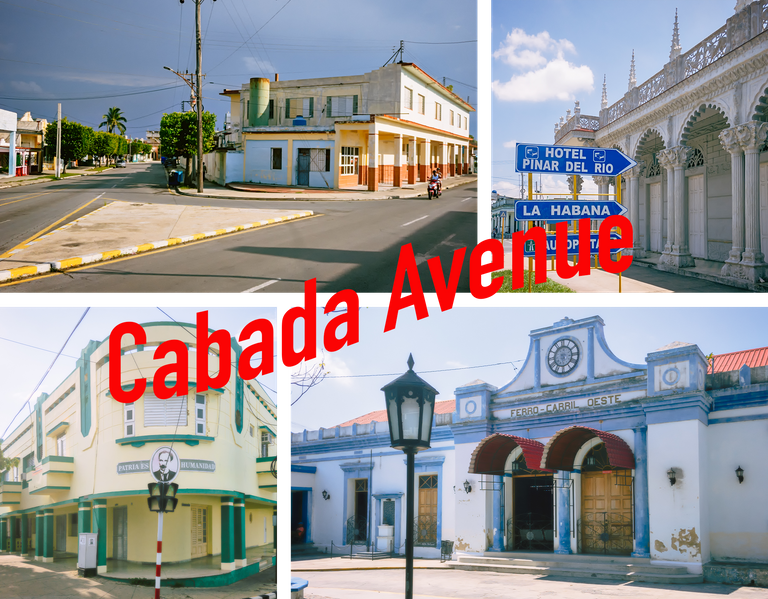
Hello friends from Hive and Pinmapple.
Today's tour will take us along a street in my city that, although not very long, is quite picturesque. I'm talking about Cabada Avenue, which is now known as Commander Pinares Avenue.
Hola amigos de Hive y de Pinmapple.
El recorrido de hoy lo realizaremos por una avenida de mi ciudad que aunque no es muy larga, si resulta pintoresca. Les hablo de la Avenida Cabada que hoy se conoce como Avenida Comandante Pinares.
Brief preamble / Breve preámbulo
Cabada Avenue begins at Recreo Street and ends in front of the Railroad Station.
According to what was agreed by the town hall on November 16, 1911, it was called just Cabada Street, which was formerly known as "Coloma Street", because the road that existed at that time led to the port of La Coloma. Its name is due to Dr. Juan María Cabada y del Haya, who was the mayor of Pinar del Río from 1916 to 1930, a Representative to the Chamber (1909-1915) and a Senator of the Republic (1931-1932).
The avenue is not very long since it is not even a kilometer long. It has two lanes for vehicular traffic and wide sidewalks, separated from the traffic by a row of laurel trees on each side, which provide shade to pedestrians and give an elegant and picturesque look to the urban landscape.
La Avenida Cabada comienza en la calle Recreo y termina frente a la Estación del Ferrocarril.
Si nos atenemos a lo que acordó el ayuntamiento el 16 de Noviembre de 1911, se llamaba solamente Calle Cabada, la que fue conocida antiguamente como "Calle Coloma", producto a que el camino que existía en ese entonces conducía al puerto de La Coloma, Su nombre se debe al Dr. Juan María Cabada y del Haya, quien fue alcalde de Pinar del Río en el período de (1916-1930), Representante a la Cámara (1909-1915) y Senador de la República (1931-1932).
La avenida no es muy extensa pues no llega al kilómetro de longitud. Tiene 2 vías de circulación de vehículos y amplias aceras peatonales, separadas de el tránsito por una hilera de laureles a cada lado, que brindan sombras a los transeuntes y le dan un aspecto elegante y pintoresco al paisaje urbano.

In this area, as in others in the city, buildings of different architectural styles and construction dates coexist, resulting from the gradual growth of the city and the remodeling or reconstruction of them. This makes it difficult to classify the buildings or frame them in a specific period and introduces a kind of stew or architectural chaos.
En esta zona, como ocurre en otras de la ciudad, coexisten edificaciones de diferentes estilos arquitectónicos y de diferentes fechas de construción, producto del crecimiento paulatino de la ciudad y de la remodelación o reconstrucción de las mismas. Esto hace difícil clasificar las edificaciones o enmarcarlas en un período determinado e introduce una especie de ajiaco o caos arquitectónico.
The tour / El recorrido
In order to be a little more organized in this story, we will take a tour of the avenue from north to south and we will stop at each of the intersections of the avenue with other streets.
El recorrido
En aras de ganar un poco en organización de este relato, haremos el recorrido de la avenida de norte a sur e iremos deteniéndonos en cada una de las intersecciones de la avenida con otras calles.
Cabada & Recreo
Right where Recreo Street merges with Vélez Caviedes Street to give way to the Central Highway, Cabada Avenue begins and right there stands one of the most emblematic and historic places in the city of Pinar del Río, the former La Jupiña Soda Factory, now Orlando Nodarse.
Justo donde la Calle Recreo se fusiona con la CalleVélez Caviedes para dar paso a la Carretera Central, nace la Avenida Cabada y justo allí se levanta uno de los lugares más emblemáticos y llenos de historia de la ciudad de Pinar del Río, la que fuera la Fábrica de Refrescos La Jupiña, hoy Orlando Nodarse.

This factory was established on June 6, 1905 under the name of Ramón González Guerra and Moisés González del Pino. On June 25, this partnership was dissolved, and Moisés González del Pino became the sole owner who later sold it to Mr. Juan Montes Crespo for $1300 in Spanish gold coins. The factory was registered with a notary under the name of "La Pinareña y la Cotorra" on August 27, 1907.
The factory was known in our town as "La Jupiña" for the production of the famous Jupiña soda, which had already been made before, and its owners had a fleet of trucks for transporting the products. Additionally, due to its fame, this factory was an agent for the Hatuey beer in the province.
This archival photo shows an advertisement from the time of the well-known soda.
Esta fábrica surgió el 6 de junio de 1905 bajo la razón social de Ramón González Guerra y Moisés González del Pino. El 25 de junio se disuelve esta sociedad, quedando como único dueño Moisés Gonzálezdel Pino, quien posteriormente la vende al señor Juan Montes Crespo, por $1300 en oro de cuño español. Esta fábrica se inscribió ante notario bajo el nombre de "La Pinareña y la Cotorra" el 27 de agosto de 1907.
La fábrica era conocida por nuestro pueblo como “La Jupiña” por la fabricación del famoso refresco Jupiña, que ya se venía elaborando con anterioridad y sus dueños contaban con una flotilla de camiones para el traslado de los productos. Por otra parte, esta fábrica, por la fama adquirida, fue agente, en la provincia, de la cerveza Hatuey
Esta foto de archivo muestra una publicidad de la época del conocido refresco.
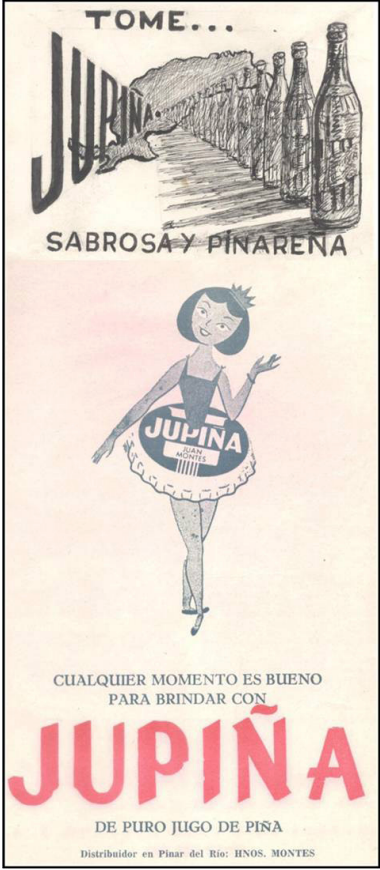
The following archival photo shows some of the products of the factory, such as seltzer water and soda.
La siguiente foto de archivo muestra algunas de las producciones de la fábrica, como agua de seltz y gaseosas.
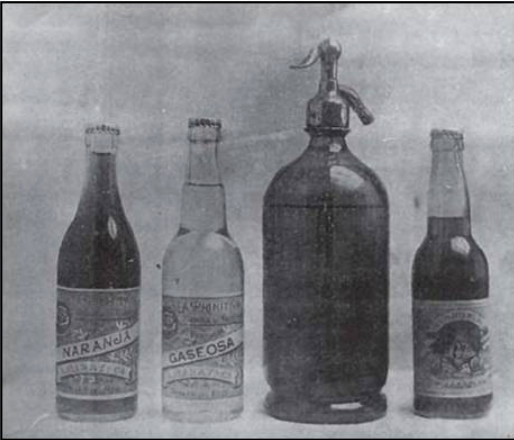
A mural painting made by renowned artists from Pinar del Río embellishes one side and the background of the factory.
Una pintura mural hecha por reconocidos artistas pinareños embellece un latereal y el fondo de la fábrica.
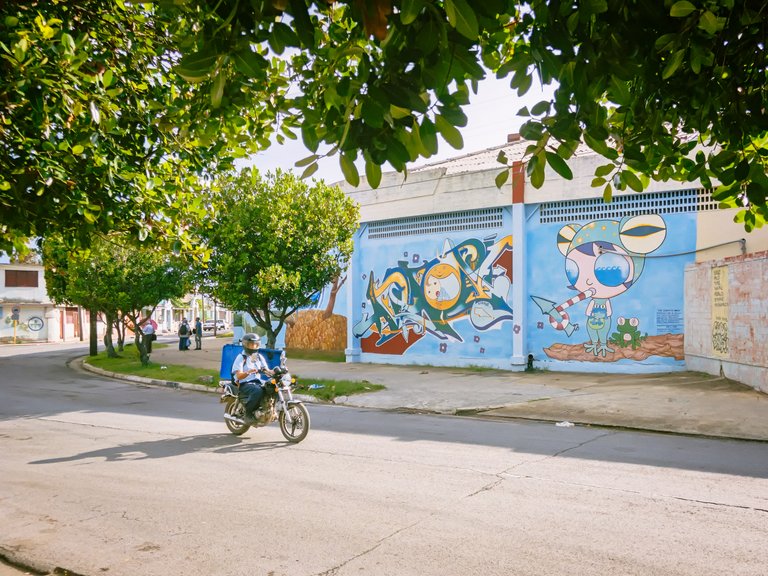
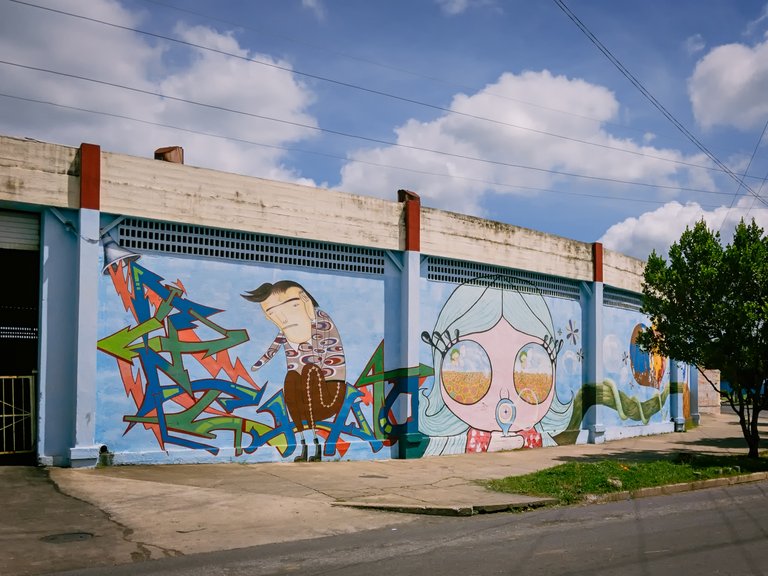
On the sidewalk in front of the factory is Alimatic, an IT services company occupying a building with architecture typical of the first half of the last century.
En la acera del frente radica la Empresa de Servicios Informáticos Alimatic, ocupando un local con una arquitectura propia de la primera mitad del siglo pasado.
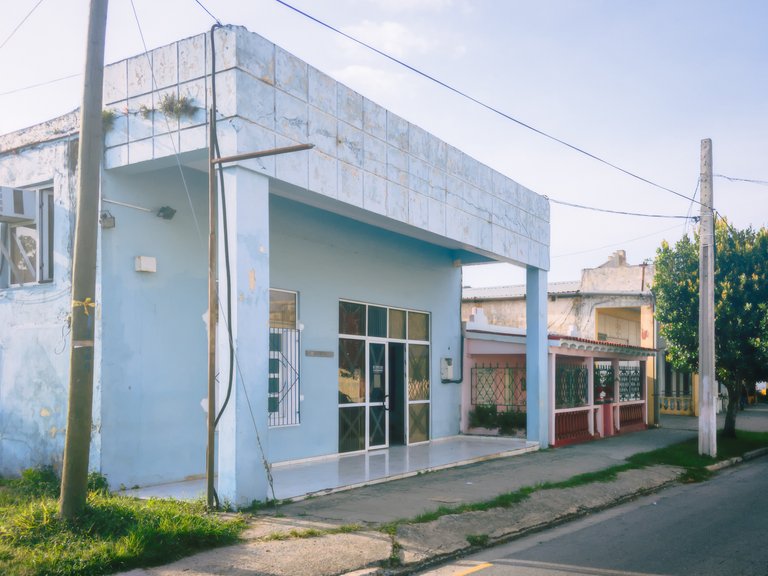
Afterward, there is a group of houses interrupted by an old warehouse belonging to the Beverage and Soda Company.
Después sigue un grupos de viviendas interrumpido por un antiguo almacén perteneciente a la Empresa de Bebidas y Refrescos.
Cabada & Colón
Colón Street is another main artery of the city. On one side of the avenue, we can see very old houses with tile roofs, while on the opposite side, we find houses from a later period. This contrast is a faithful reflection of what we find in this stretch of the tour.
La Calle Colón es otra de las principales arterias de la ciudad. Allí podemos ver de un lado de la avenida unas casas muy antiguas, de techos de teja, mientres que en el lado opuesto nos encontramos viviendas de una época posterior. Este contraste es fiel reflejo de lo que encontramos en este tramo del recorrido.
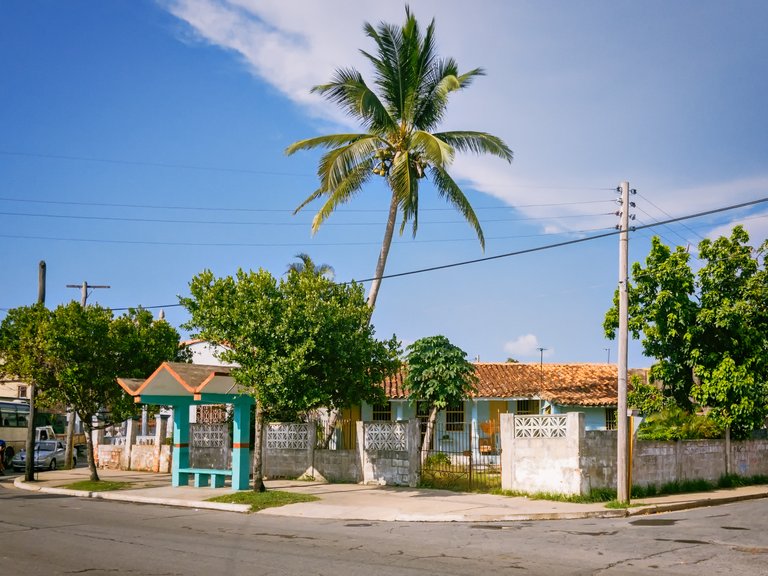
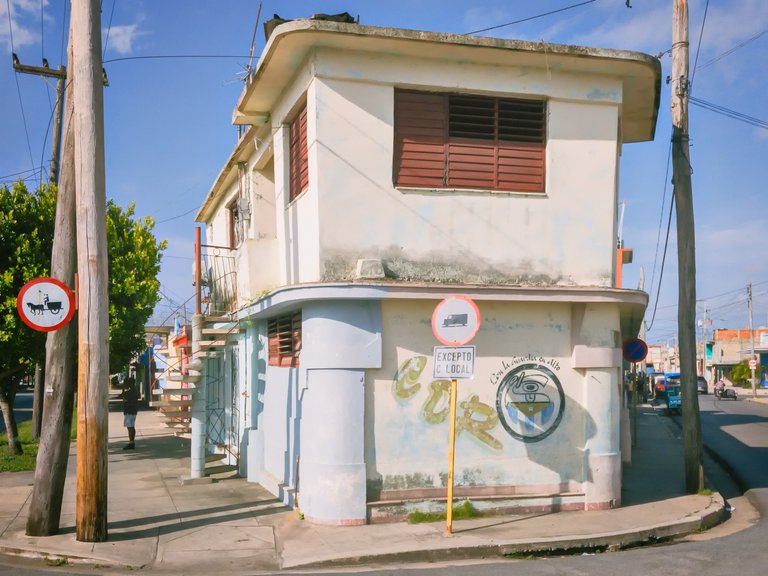
Cabada & Emilio Núñez
On one of the corners, there is a residential building that breaks the routine imposed by the rest of the buildings in the area. On the ground floor, there is a pharmacy named after a cabaret that once occupied the space, the Linjoo Cabaret.
En una de las esquinas se levanta un edificios de vivienda que rompe la rutina que imponen el resto de las edificaciones del lugar. En la planta baja hay una farmacia que lleva el nombre de un cabaret que ocupó ese espacio, el Cabaret Linjoo.
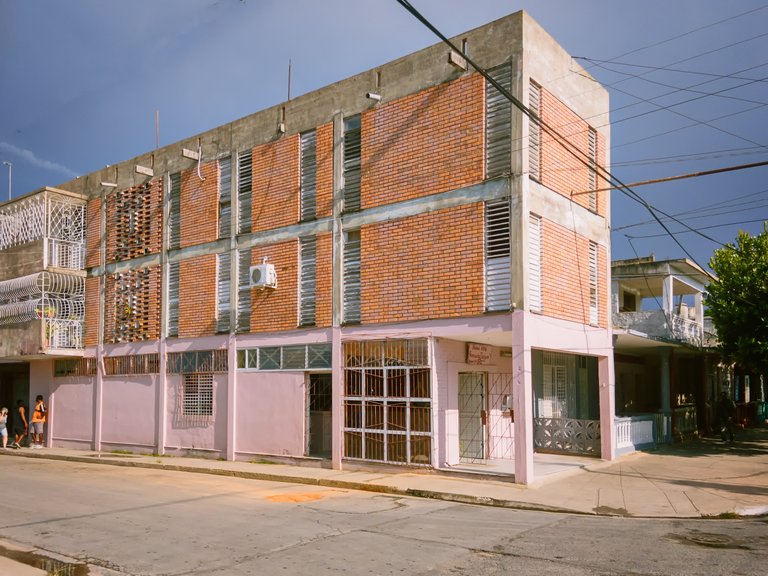
Cabada & Roldán
There, the four corners have small triangular parks with benches, where the local residents and other passersby often sit at night to chat or connect to the internet and enjoy the little bit of coolness available on hot summer nights. In the afternoons, children can be seen playing or riding their bikes.
Alli las cuatro esquinas cuentan con pequeños parques triangulares con bancos, donde los vecinos del lugar y otros transeuntes suelen sentarse por las noches para conversar o paara consctarse a internet y tomar el poco fresco que ahy en las muy cálidas noches veraniegas. En las tarde suelen verse niños jugando o montando en sus bicicletas.
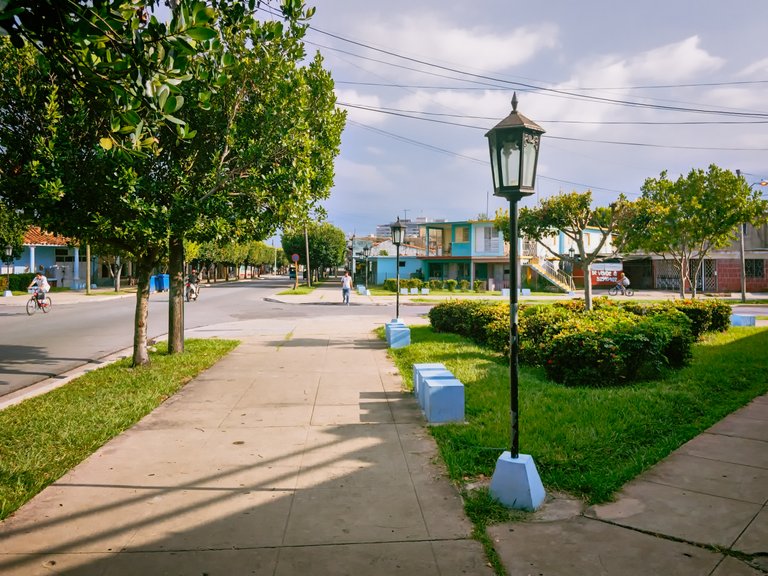
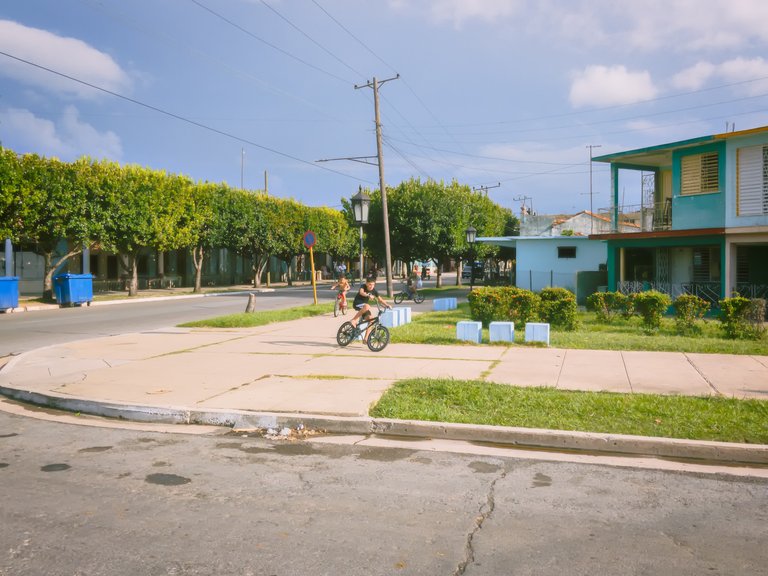
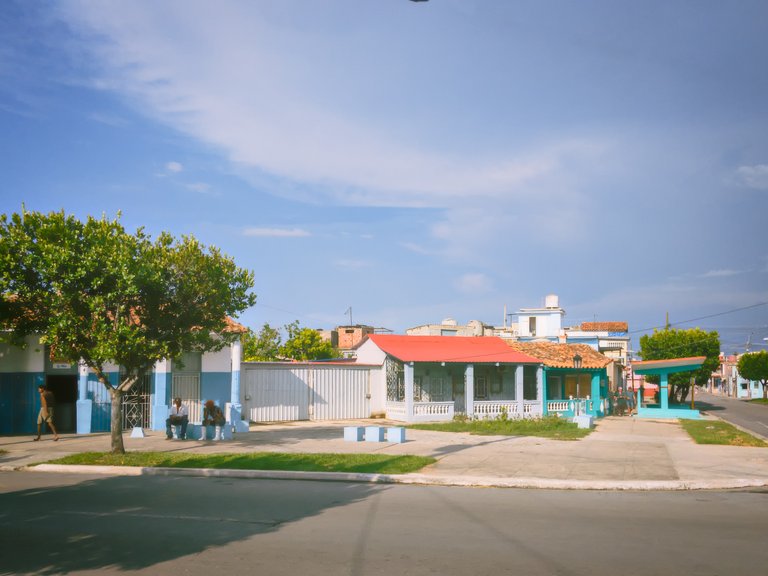
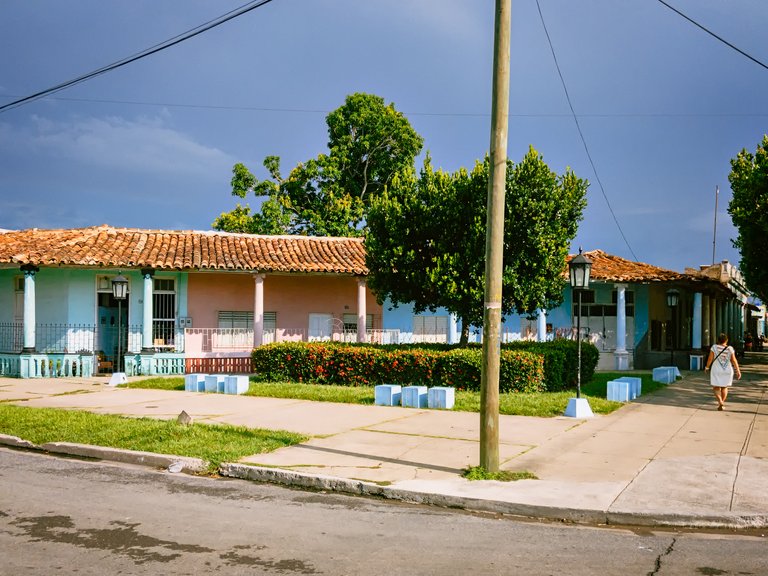
Right next to one of these little parks, we come across a grocery store that sells food to the local population.
Justo al lado de uno de estos parquecitos nos encontramos una bodega de venta de víveres a la población.
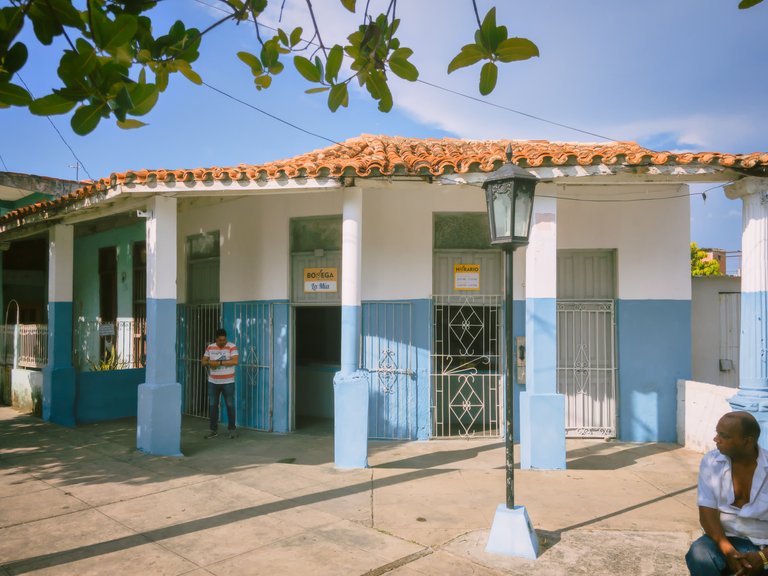
Before reaching the next intersection, we find some small private businesses owned by local entrepreneurs, who have gradually spread throughout the avenue and the rest of the city as a way of supporting their families.
Antes de llegar a la siguiente intersección encontramos algunos pequeños negocios privados de emprendedores locales, quienes poco a poco se han ido extendiendo por la avenida y por el resto de la ciudad como una forma más de subsistencia familiar.
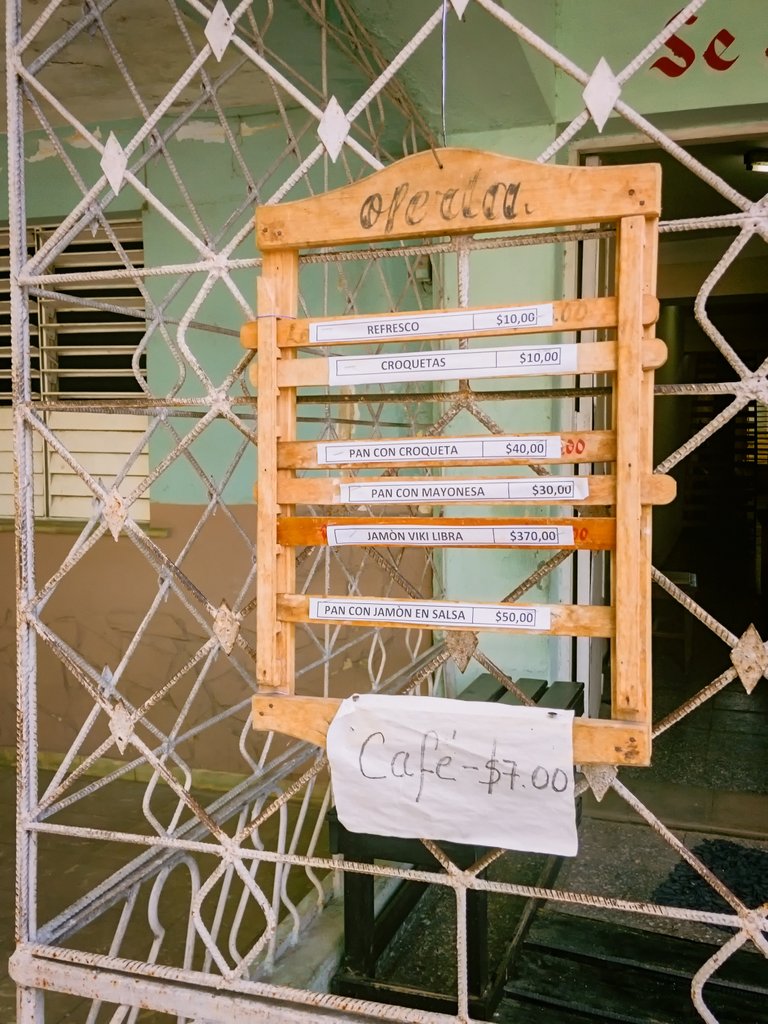

Cabada & Agramonte
Here, there is a horse carriage stand that has been used for several years to transport people to other areas of the city, replacing other types of public transportation that do not always meet the population's demand.
Aqui hay una piquera de coches de caballo que desde hace varios años se utilizan para el traslado hacia otras zonas de la ciudad, en sustitución de otros tipos de transportes público, que no siempre satisface la demanda de la población.
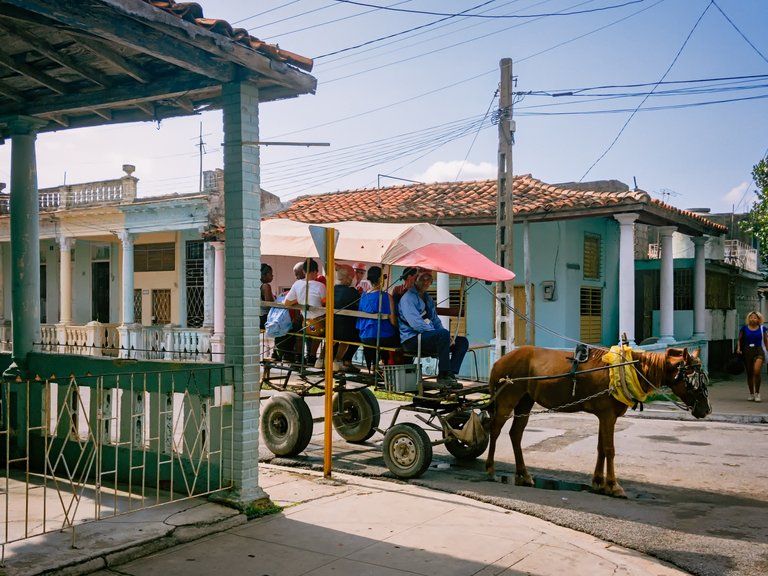
In this block, you can find more private family-owned businesses, especially those that sell light food.
En esta cuadra se pueden encontrar más negocios privados familiares, sobre todo de venta de alimentos ligeros.
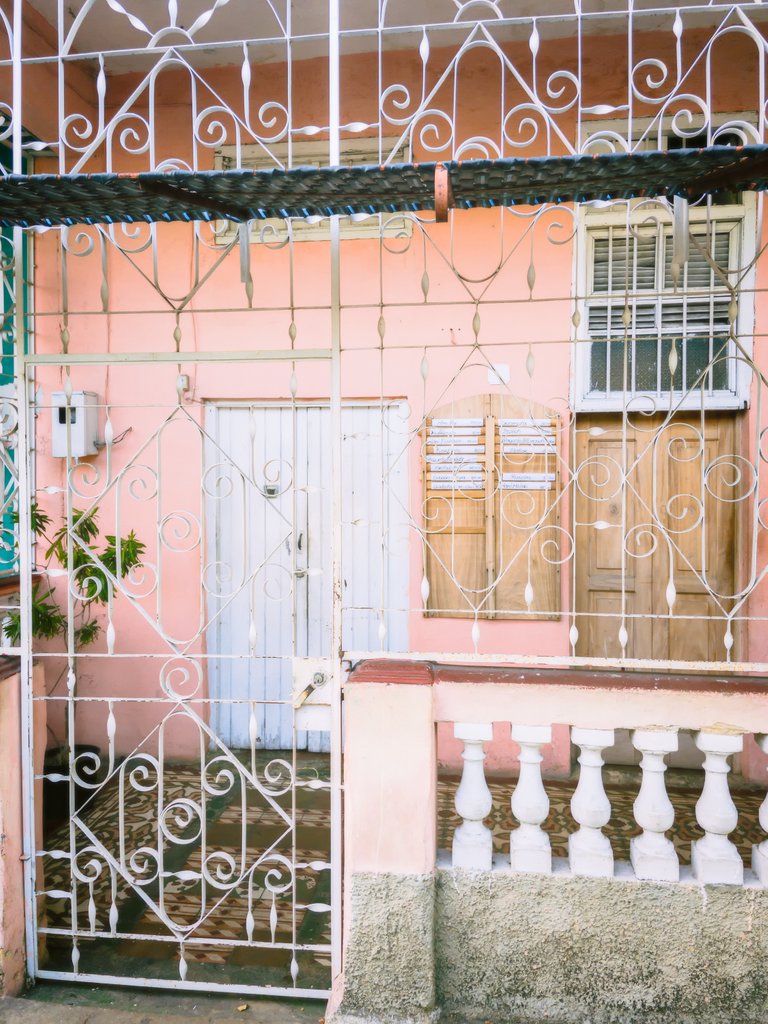
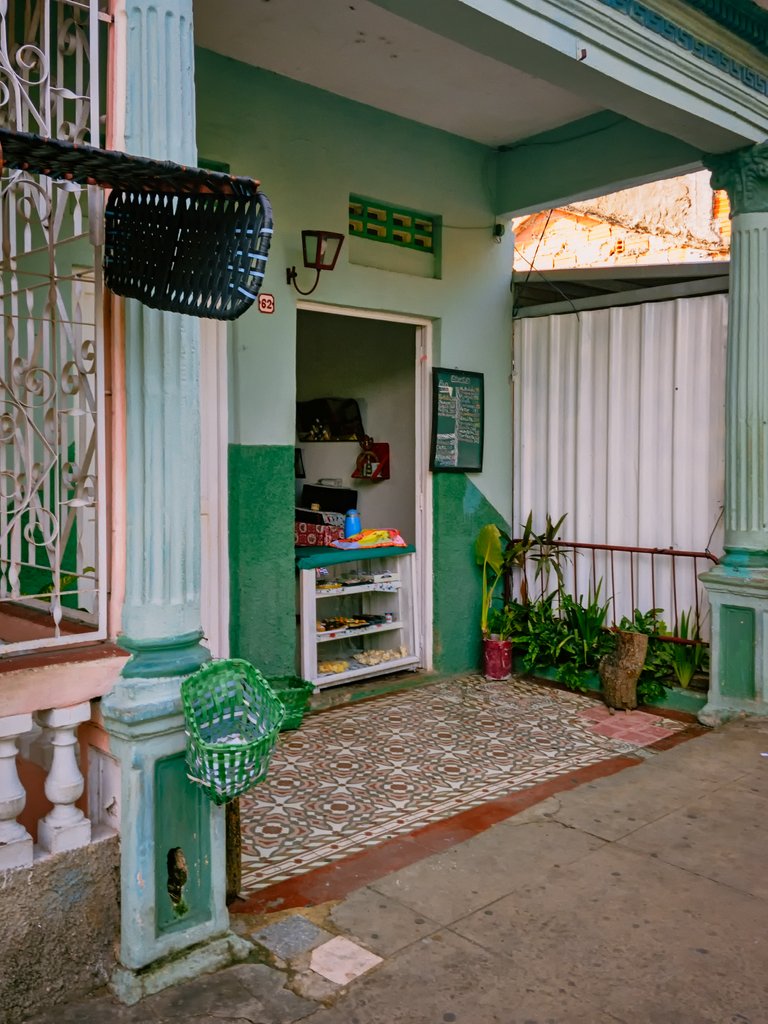
The intelligence, initiative, and even humor of the owners of these businesses are evident in the advertising boards they display to the public.
El ingenio, la iniciativa y hasta el humor de los propietarios de estos negocios se pone de manifiesto en las pizarras de publicidad que muestran al público.
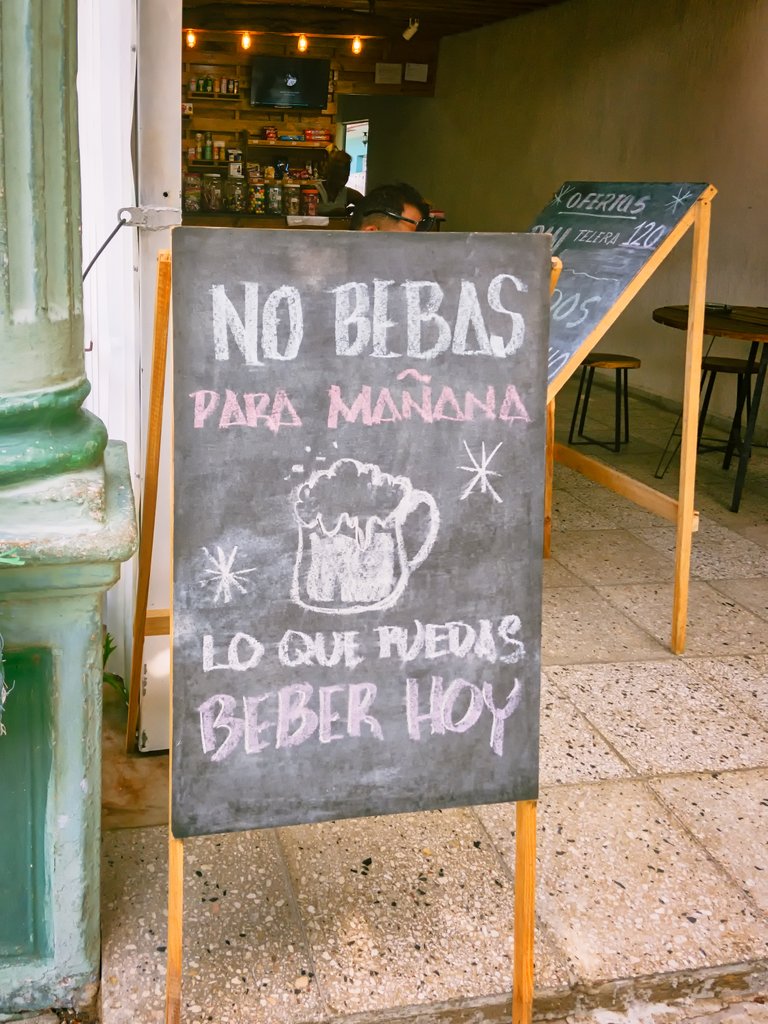
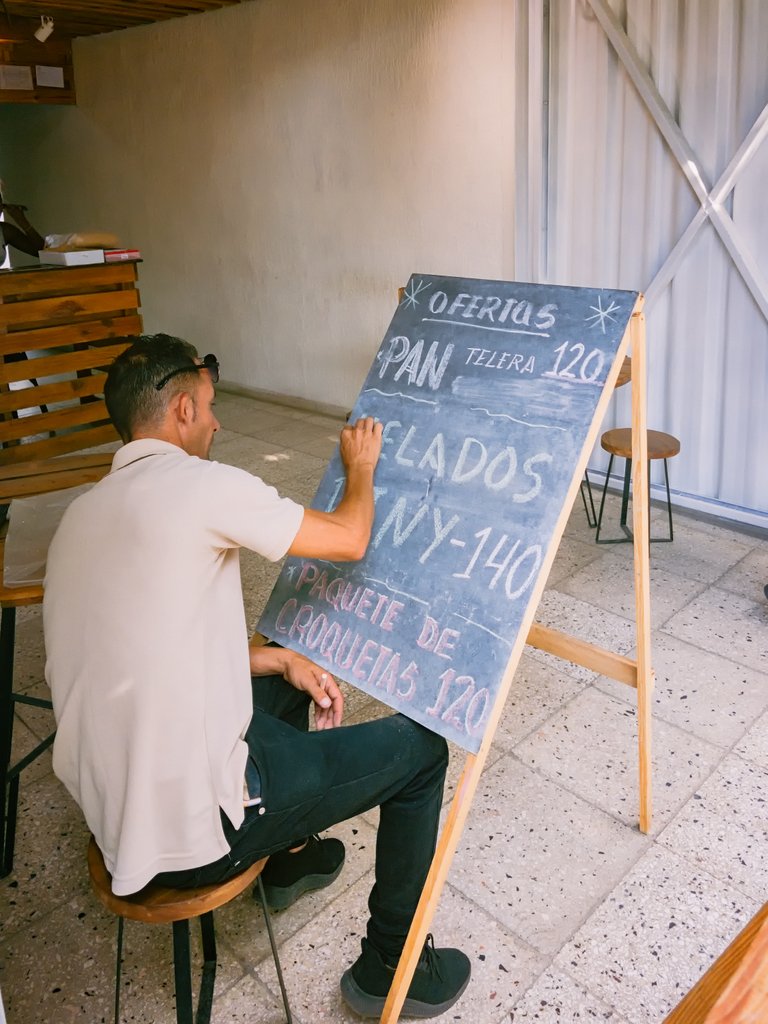
Cabada & Céspedes
As Cabada Avenue converges with Mariana Grajales Street, a triangle is formed where La Esquina store (better known as El Cuchillo), a small state-run store belonging to the Panamericanas chain, is located. On one side, there is a hardware store and in the back, there is a product delivery center linked to e-commerce.
For many years, a gas station (El Cuchillo) operated at this site, where other transportation-related services were also provided. However, it was removed from the location because it posed a danger to the neighbors due to the increase in the population of the surrounding areas.
Al converger la avenida con la Calle Mariana Grajales, se forma un triángulo que sirve de asentamiento a la tienda a La Esquina (más conocido con El Cuchillo), un pequeño comercio estatal perteneciente a la cadena Tiendas Panamericanas. Por el lateral hay una ferretería y al fondo un centro de entrega de productos vinculadoal comercio electrónico.
En este sitio funcionó durante muchos años una gasolinera (El Cuchillo), donde además se brindaban otros servicios relacionados con el transporte. Esta fue retirada del lugar poruqe constituía un peligro para los vecinos ante el incremento de la poblaación de los alrededores.
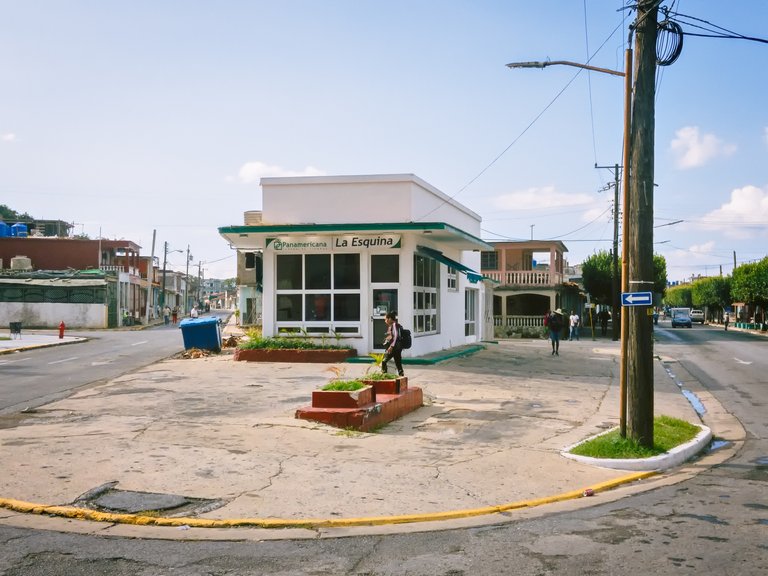
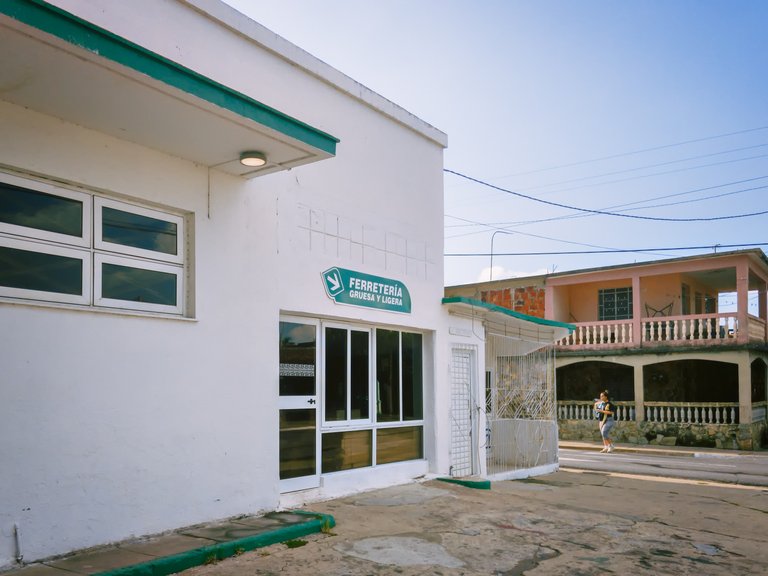
At the same place where Cabada Avenue and Mariana Grajales Street merge, Isabel la Católica Street, now Adela Azcuy, begins and there stands out the original and beautiful decoration of the walls of the houses near that corner.
En el mismo lugar que se fusionan la Avenida Cabada y la Calle Mariana Grajales nace la Calle Isabel la Católica, hoy Adela Azcuy y allí se destaca la original y bella decoración de los muros de las viviendas próximas a esa esquina.
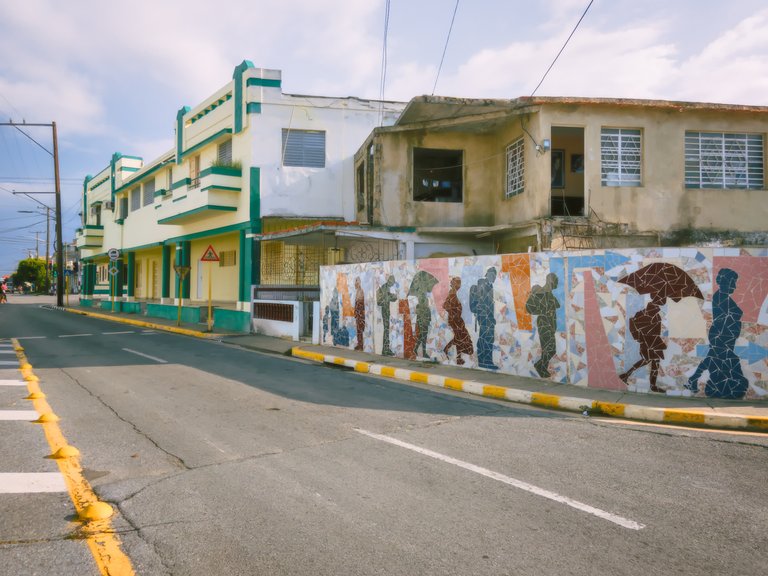
Right in front of El Cuchillo is the Territorial Office of Standardization, the governing center for Standardization, Metrology, and Quality Management activities.
Justo en frente a El Cuchillo radica la Oficina Territorial de Normalización, centro rector de las actividades de Normalización, Metrología y Gestión de la Calidad.

Cabada & Martí
This is one of the main intersections in the city since it provides access to the National Highway, the Central Highway, the Viñales Road, the La Coloma Road, and the Luis Lazo Road.
Here, there is also one of the most peculiar and beautiful buildings in the country, the Guasch Palace, due to its eclecticism. I remember that I dedicated a post to it at one point.
Este es uno de los principales cruces de calles de la ciudad puesto que a partir de el se accede a la Autopista Nacional, a la Carretera Central y la Carretera a Viñales, a la Carretera a La Coloma y a la Carretera a Luis Lazo.
Aquí también hay uno de los edificios más peculiares del país, por su eclecticismo y su belleza, el Palacio de Guasch, al que en su momento dediqué una publicación.
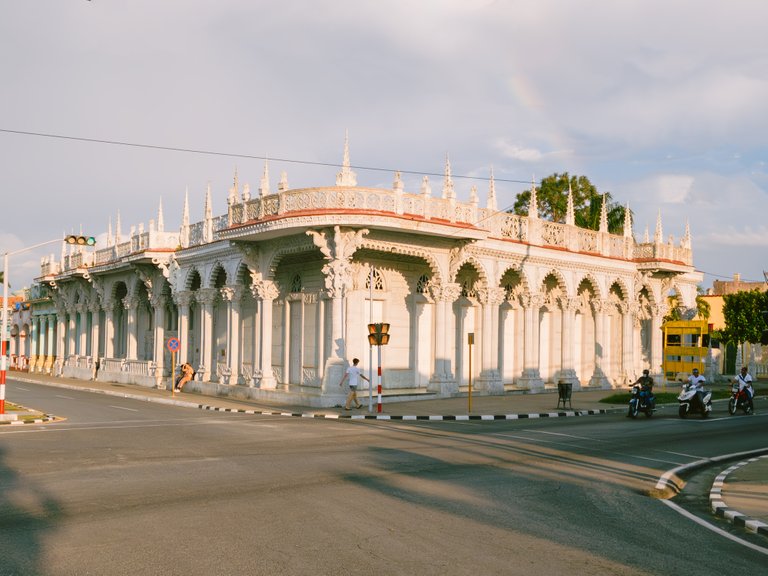
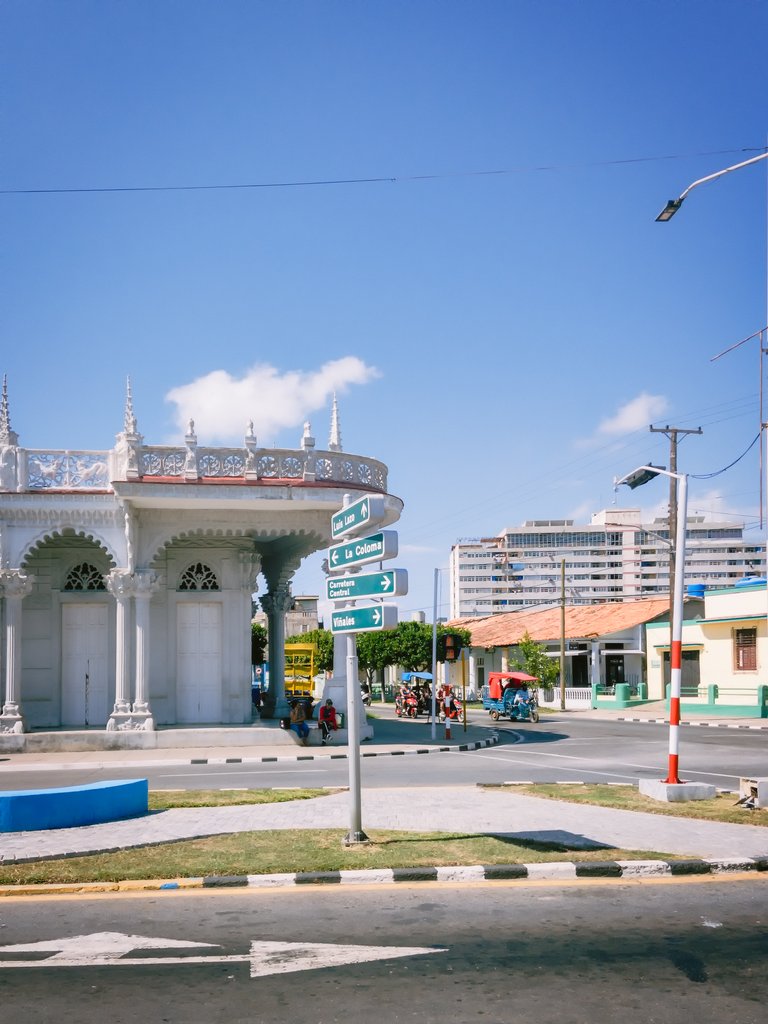
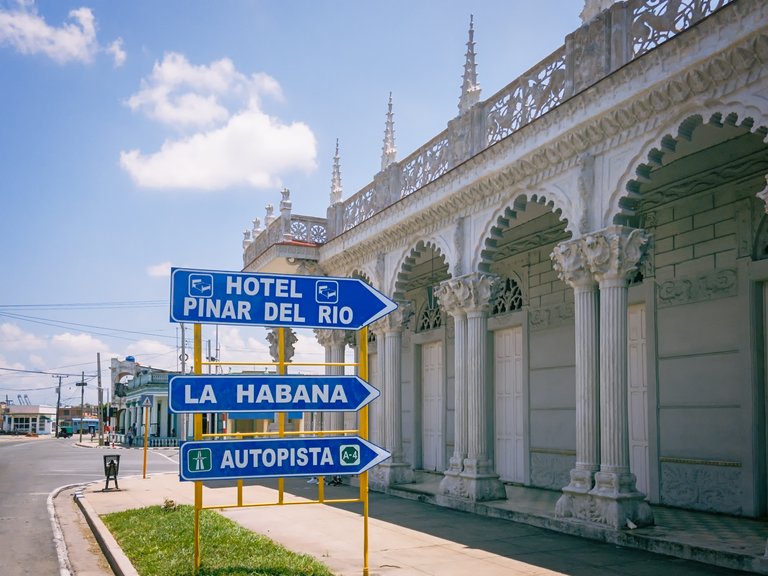
On the opposite diagonal corner, we find a two-story building that now houses a unit of the Provincial Health Directorate. As far as I know, this building used to be a medical cooperative where several specialists had their offices.
En la esquina opuesta diagonalmente nos encontramos con un edificio de dos plantas que hoy ocupa una dependencia de la Dirección Provincial de Salud y que según tengo entendido, en su momento fuera una cooperativa médica, donde varios especialistas tenían sus consultorios.


On the other two corners, there were residential houses, one of which still stands as such, while the other is now a health promotion and education center.
En las otras dos esquinas habían casas de viviendas, una de las cuales aún se mantiene como tal, mientras que la otra hoy es un centro de promoción y educación para la salud.
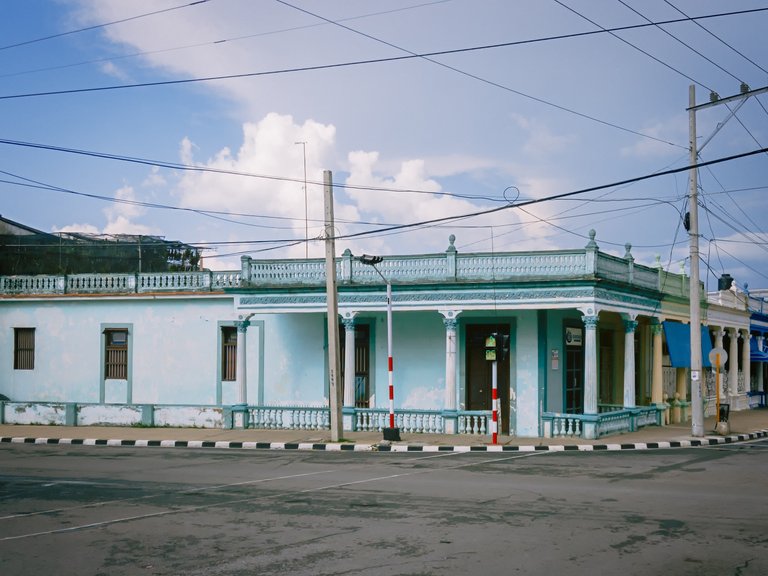
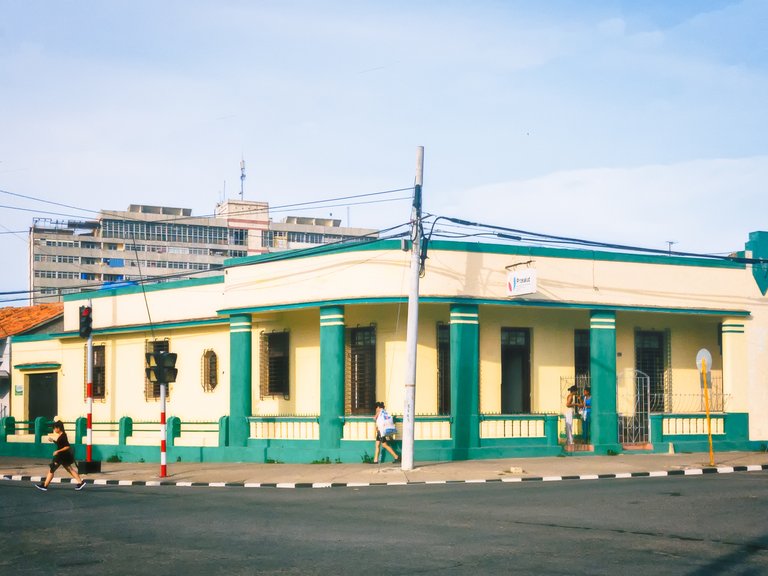
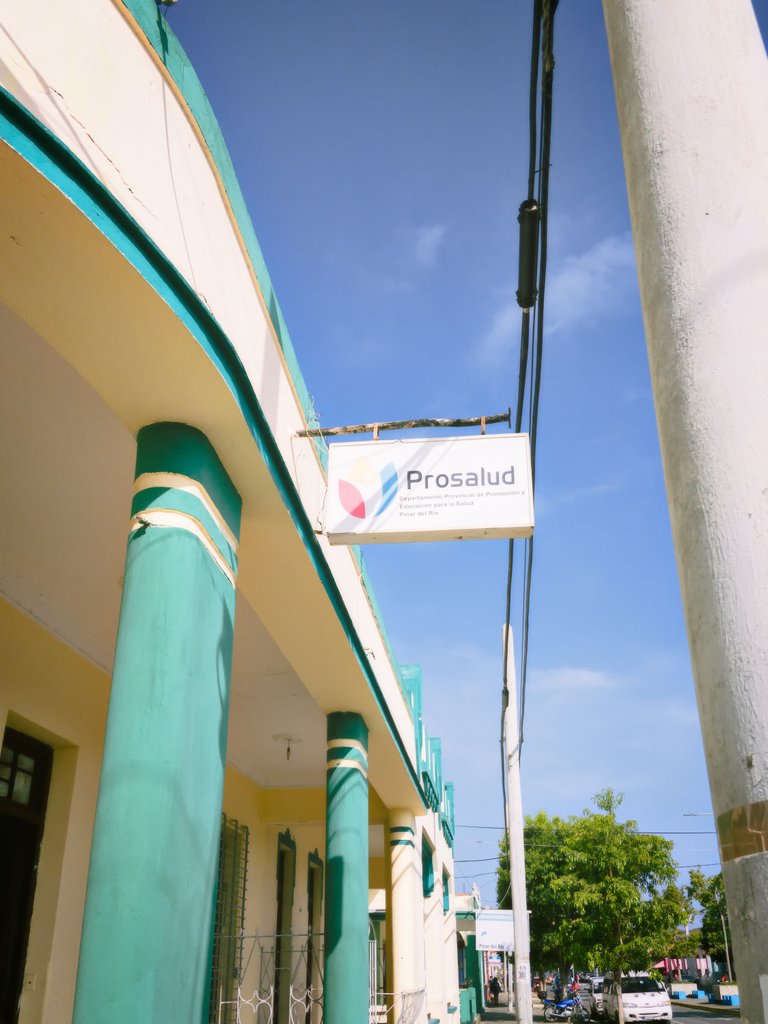
Before 1959, from Martí Street to the train station, it was one of the areas of the city where middle and upper-class people settled, such as professionals, public figures, etc. This is reflected in the architecture, which was more varied and more advanced for the time, aesthetically speaking.
Antes del 1959, a partir de la Calle Martí y hasta la estación del ferrocarril es una de las zonas de la ciudad donde se asentaron pobladores de las clases media y alta, como profesionales, personas públicas, etc. Esto se refleja en la arquitectura, siendo más variada y más avanzada para la época, estéticamente hablando.
Other buildings that stand there or very close by reflect the economic position of those who inhabited them. In some of these houses, there are now private businesses renting rooms, and there is even a small food bar.
Otras edificaciones que se levantan allí o muy próximas reflejan la posición económica que quienes las habitaban. En algunas de esas viviendas hoy en día existen negocios privados de renta de habitaciones y hay hasta un pequeño bar con comida.
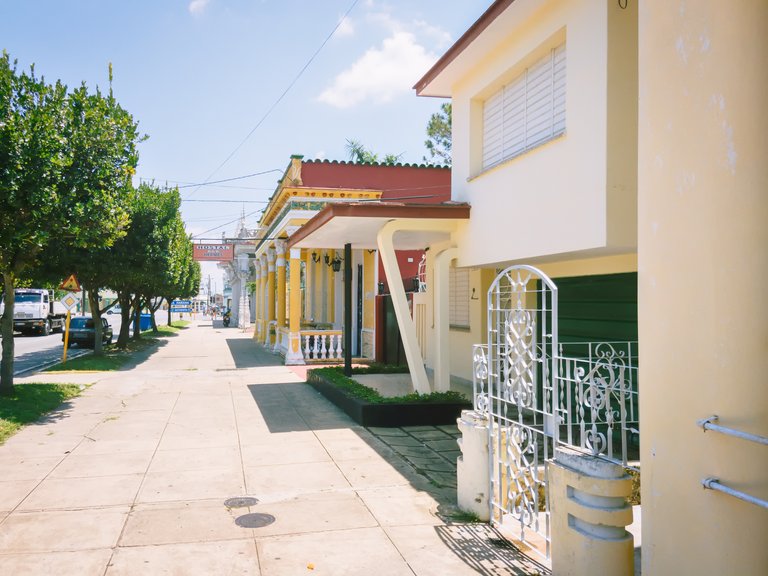
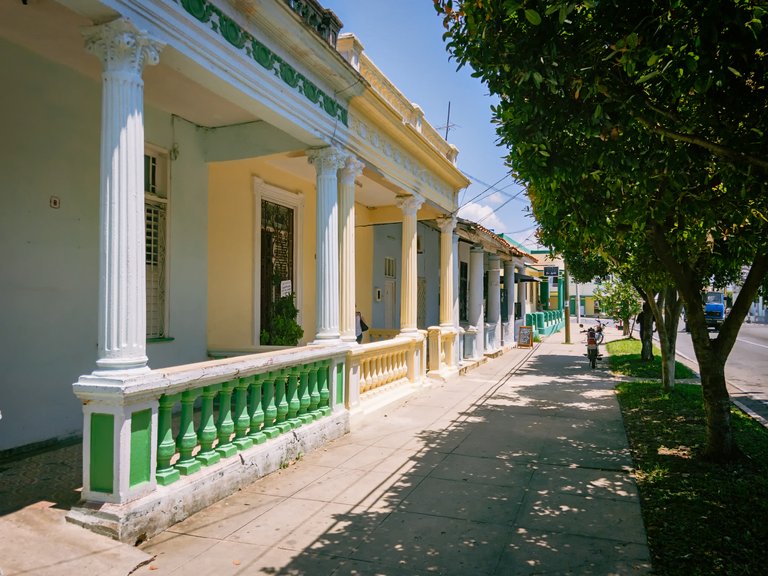
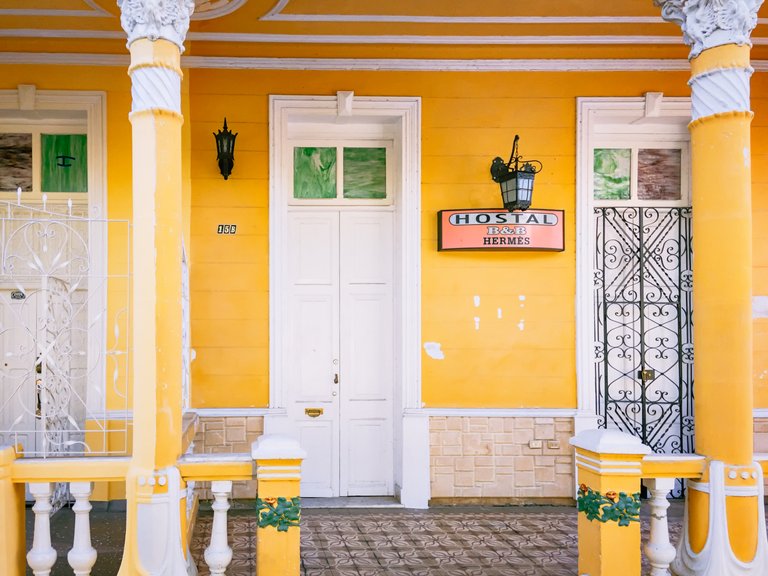
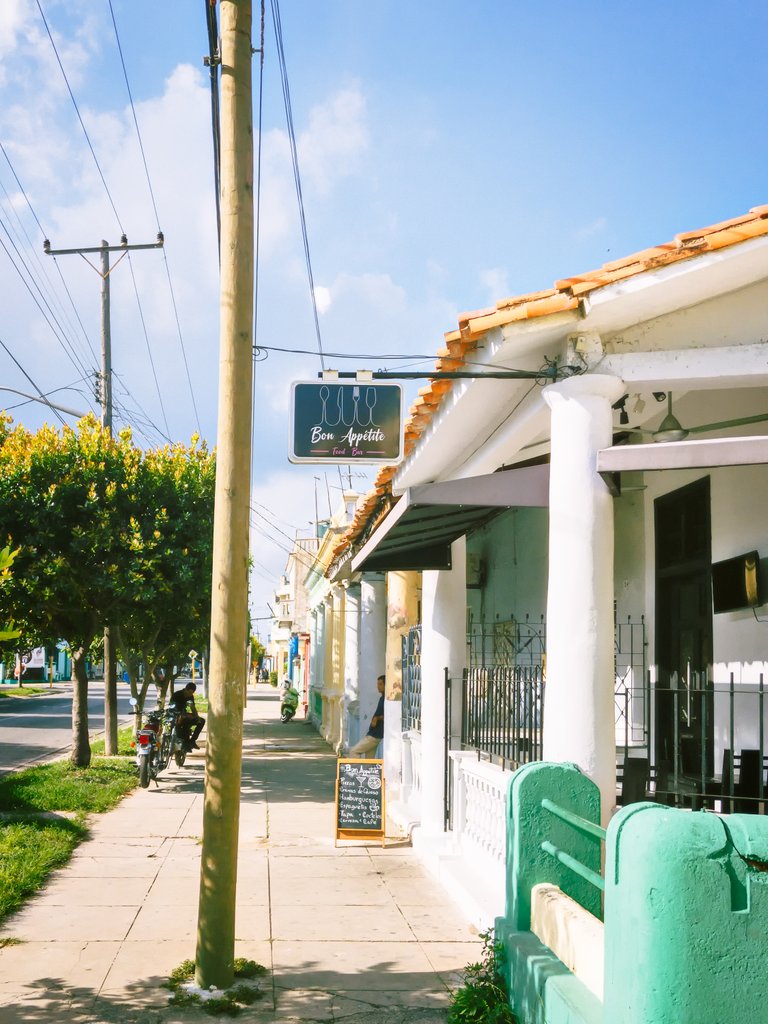
Cabada & Máximo Gómez
On this corner, we find a classic building of the city's architecture. It was built by architect Rogelio Pérez Cubillas in the 1950s. This building served as a residence for an eminent Pinareño surgeon, Dr. Sergio J. Cuervo Castillo, born in San Luis in December 1904. He graduated in Havana in 1928 and was the director of the Sanatorium of the Spanish Colony, known as La Quinta (today a Pediatric Hospital). The main entrance and access to his private medical practice were located on this corner.
En esta esquina encontramos un edificio clásico de la arquitectura de la ciudad. Fue construido por el Arq. Rogelio Pérez Cubillas en la década del 50. Este edificio sirvió de residencia a un eminente cirujano pinareño, el Dr. Sergio J. Cuervo Castillo, nacido en San Luis en didicemre de 1904, se graduó en La Habana en 1928 y fue director del Sanatorio de la Colonia Española, conocido como La Quinta (Hoy Hospital Pediátrico). En esa esquina se ubicaba la entrada principal y acceso a su consulta privada.

On the other corners and throughout the rest of this stretch, there are also original buildings with beautiful architecture that were once in their prime.
En las otras esquinas y en el resto de este tramo también se levantan edificaciones originales por su arquitectura y muy bellas en su momento de espendor.
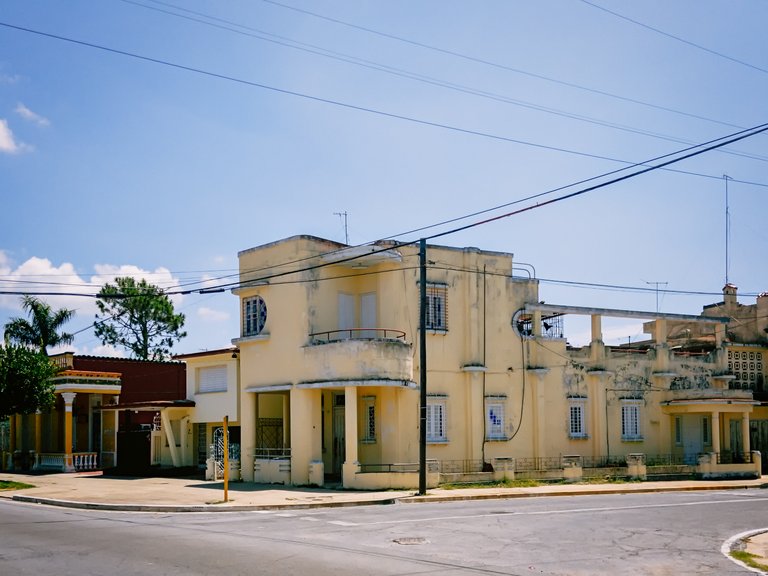
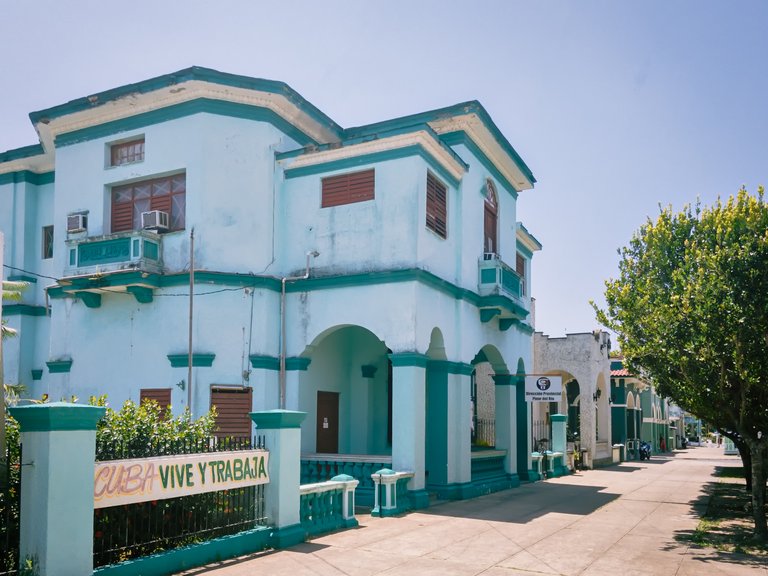

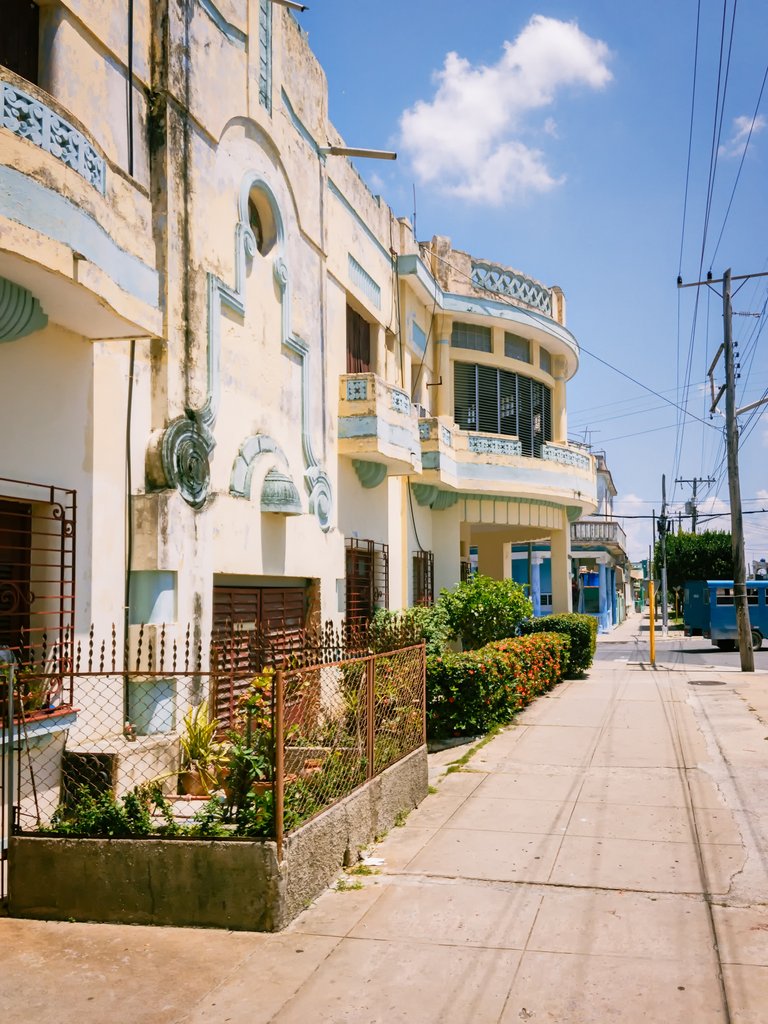
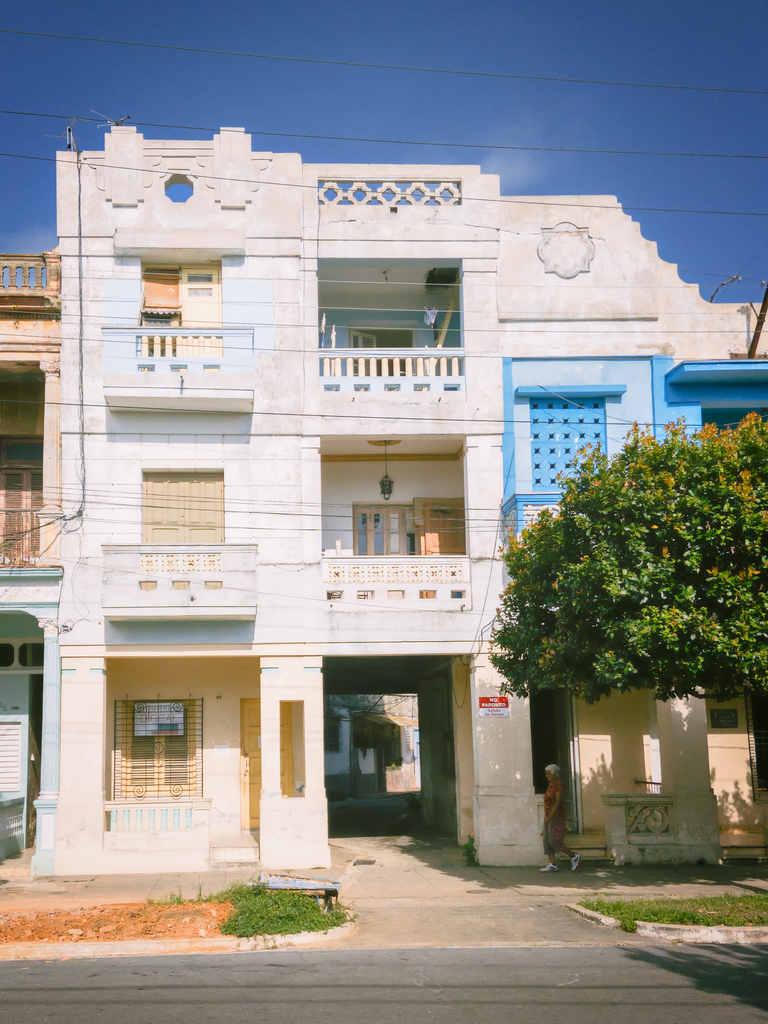
###Cabada & R. Méndez
R. Méndez Street is one of the smallest in Pinar del Río, not exceeding 100 meters in length. It starts at Cabada Avenue and ends at Hermanos Saiz Street. On its two corners, there are houses that were once true chalets and are now occupied by some state institutions.
La Calle R. Méndez es una de las más pequeñas de Pinar del Río, no supera los 100 metros de longitud, comienza en Cabada y termina en la Calle Hermanos Saiz. En sus dos esquinas hay casas que en su momento fueron verdaderos chalet y que hoy ocupan algunas instituciones estatales.

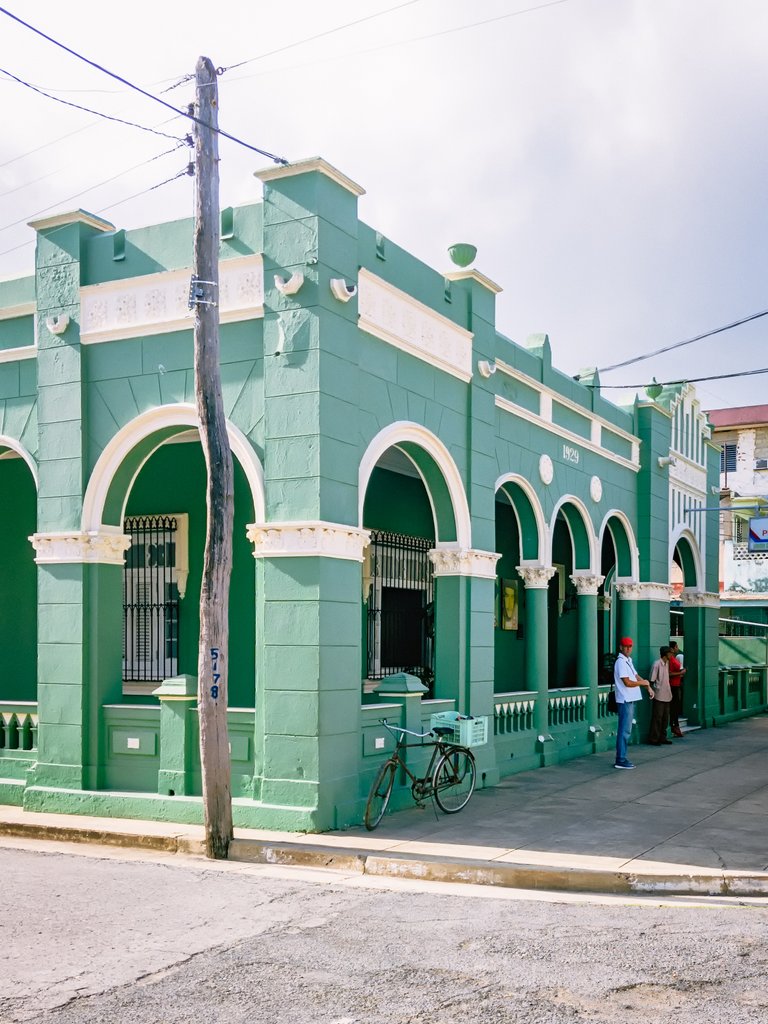
Cabada & Maceo
A few meters before reaching this street intersection is the Provincial Fire Department. The photo used is from the archive, obtained from the internet.
A pocos metros y antes de llegar a este cruce de calles radica el Cuerpo Provincial de Bomberos. La foto utilizada es de archivo, obtenida en Internet.
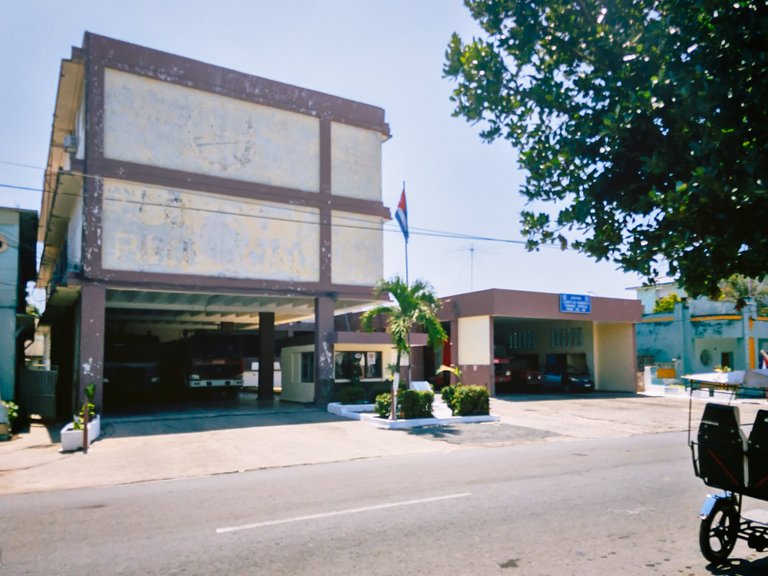
On one of the corners, the Provincial Savings Bank (BPA) has its headquarters.
En una de las esquinas tiene su sede la Dirección Provincial del Banco Provincial de Ahorro (BPA).
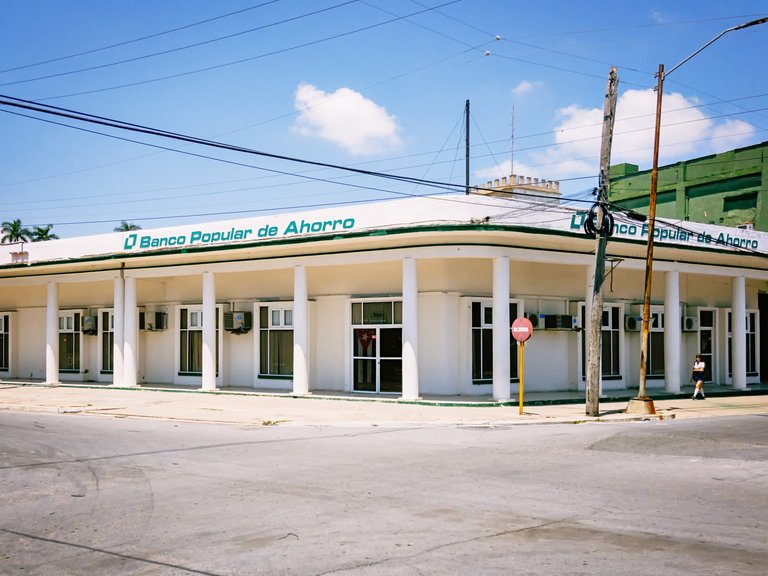
On the opposite sidewalk, there is a beautiful building that used to be the Ministry of Public Works and now houses the headquarters of the Provincial Communist Party (PCC).
Por su parte, en la acera del frente se levanta una bella isntalaación que en su momento fuera el Ministeriod de Obras Públicas y que hoy ocupa la sede del PCC Provincial.
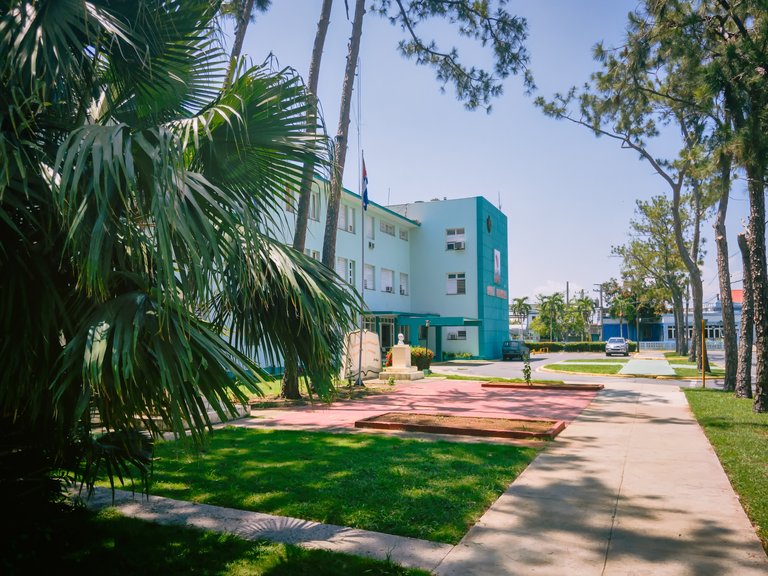
Cabada & Ferrocarril
Here, Cabada Avenue ends, and it could not be in a more beautiful and historic place. It is necessary to briefly tell the story of this place.
First, it should be noted that Cuba was the first country in Latin America and one of the first in the world, including Spain, to have a railway. On October 12, 1834, the Spanish government gave the Fomento Board, then chaired by the Count of Villanueva, the order to undertake the work of the "iron road" from Havana to the town of Güines. The opening date of the first section of the railway was set for November 17, 1837, as a tribute to Queen Isabel the Catholic, who celebrated her birthday that same day.
Little by little, the railway was extended to other territories. In 1943, it reached Güines, in 1844 to Batabanó, in 1845 to San Antonio de los Baños, in 1846 to Unión de Reyes, and on August 1, 1849, the train entered, for the first time, the Vuelta Abajo territory, through the municipality of Guanajay.
On August 6, 1858, the Municipal Board of Pinar del Río attended a request from the West Iron Road Company to obtain the concession to connect Havana with Pinar del Río by railway. From 1860, land communications from the Vuelta Abajo regions to the rest of the island began to be carried out from Guanajay, which linked it in parallel lines with Havana. To reach that jurisdiction, travelers were obliged to make that long and rough stretch by "volantas", carts, or horses, which represented progress in those memorable times.
Taking into account the need to connect Havana with the western region of the country, on October 31, 1857, the Governor General of the Island granted a provisional concession to build the railway line from the city of Havana to the town of Pinar del Río. This provisional concession was confirmed by Royal Order dated October 13, 1858, to the so-called West Railway under the direction of the Pedroso brothers.
On March 22 of that same year, civil works had already begun. Nine years later, on January 25, 1867, at approximately three o'clock in the afternoon, the West Railway reached the place known as "Puente del Burro," 3 km from San Cristóbal. The construction of the railway progressed very slowly due to various economic disputes between the regents of the West Railway and the government of the province. It was not until 1880 that the train reached Consolación del Sur.
It took nearly 14 years for the railway to finally reach Pinar del Río. The first train arrived in Pinar del Río on April 15, 1894. The jubilation caused by this extraordinary event was so great that the city was decorated. From all angles, the people gathered along the Real or Mayor Street (now José Martí) to leave at the indicated time to the station to participate in the inauguration by the Governor General of the Island, Emilio Callejas e Isasi, who accompanied by his wife and high military officers, journalists, and other guests traveled on a special train to the provincial capital. It was a day of celebration, of unforgettable memory.
The last agreement signed by the Spanish government with the West Railways was to authorize the extension of the railway line to the municipality of Guane on November 24, 1898. This last section of the railway was inaugurated on February 10, 1908.
The train station was remodeled a few years ago, and the first thing we find is a beautiful park where travelers or other residents usually rest in the shade of the trees.
Aquí muere la Avenida Cabada y no podía ser de otra forma que en un bello y lleno de historia lugar. Resulta obligado aquí contar brevemente esa historia.
Primero hay que decir que Cuba fue el primer país de latinoamérica y uno de los primeros del mundo, incluyendo a España, que contó con ferrocarril, pues el el 12 de octubre de 1834, el gobierno español entregó a la Junta de Fomento, presidida en aquel entonces por el Conde de Villanueva, la orden de emprender la obra del “camino de hierro” de La Habana a la Villa de Güines. La fecha de inauguración del primer tramo del ferrocarril se fijó para el día 17 de noviembre de 1837, como homenaje a la Reina Isabel la Católica, que celebraba su natalicio ese mismo día.
Poco a poco el ferrocarril fué extendiéndos a otros territorios, en 1943 llegó hasta Güines, en 1844 hasta Batabanó; en 1845 a San Antonio de los Baños; en 1846 a Uniónde Reyes, y el 1° de agosto de 1849 el tren entraba, por primera vez, en el territorio vueltabajero, por el municipio de Guanajay.
El 6 de agosto de 1858 la Junta Municipal de Pinar del Río atendió una petición de la Empresa del Camino de Hierro del Oeste para obtener la concesión de unir a La Habana con Pinar del Río por el ferrocarril. A partir de 1860, también las comunicaciones terrestres de las regiones vueltabajeras con el resto de la Isla comenzaron a realizarse desde Guanajay, que la enlazaba por las líneas paralelas con La Habana y para llegar a esa Jurisdicción los viajeros estaban obligados a realizar ese largo y escabroso tramo por medio de volantas, carretas o caballos, por lo que representó un avance en aquellos memorables tiempos.
Teniendo en cuenta la necesidad de unir a La Habana con la zona occidental del país, con fecha 31 de octubre de 1857, el Gobernador General de la Isla le había otorgado una concesión provisional para que construyeran la línea férrea desde la ciudad de La Habana a la villa de Pinar del Río. Esta concesión provisional fue confirmada por Real Orden de fecha 13 de octubre de 1858 al denominado Ferrocarril del Oeste bajo la dirección de los hermanos Pedroso.
El 22 de marzo de ese mismo año ya se habían emprendido las obras civiles. Nueve años después, o sea, el 25 de enero de 1867,
aproximadamente a las tres de la tarde el Ferrocarril del Oeste llegaba al lugar conocido por “Puente del Burro” a 3 Km de San Cristóbal. La construcción del ferrocarril avanzó muy lentamente a causa de diversos litigios económicos entre lo regentes del Ferrocarril del Oeste y el Gobierno de la provincia. No fue hasta el año 1880 que el tren llegó a Consolación del Sur.
Para que finalmente el ferocarril llegara a Pinar del Río hubo que esperar cerca de 14 años. El primer tren llegaría a Pinar del Río el 15 de abril de 1894. Fue tanto el júbilo que causó este extraordinario acontecimiento que la ciudad fue engalanada. Desde todos los ángulos el pueblo se aglomera a todo lo largo de la calle Real o Mayor (hoy José Martí) para partir a la hora indicada al paradero a participar en la inauguración por el Gobernador General de la Isla, Emilio Callejas e Isasi, quien acompañado de su esposa y altos jefes militares, periodistas y otros invitados viajaban en un tren especial hasta la capital de la provincia. Fue un día de fiesta, de inolvidable recordación.
El último acuerdo suscrito por el gobierno español con la firma de los Ferrocarriles del Oeste fue el de autorizar la extensión de la línea férrea hasta el municipio de Guane, el 24 de noviembre de 1898. Este último tramo del ferrocarril se inauguró el 10 de febrero de 1908.
Esta estación fue remodelada hace pocos años y lo primero que nos encontramos es un bello parque donde los viajeros u otros pobladores suelen descansar a la sombra de los árboles.
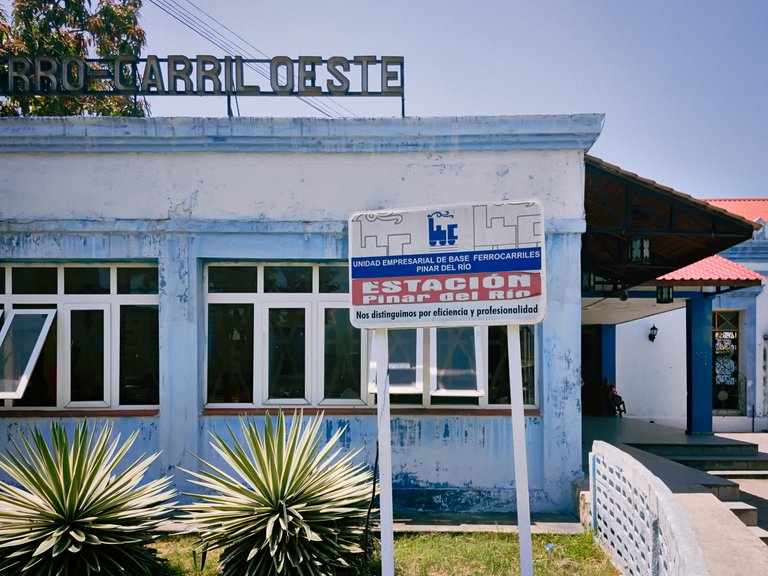
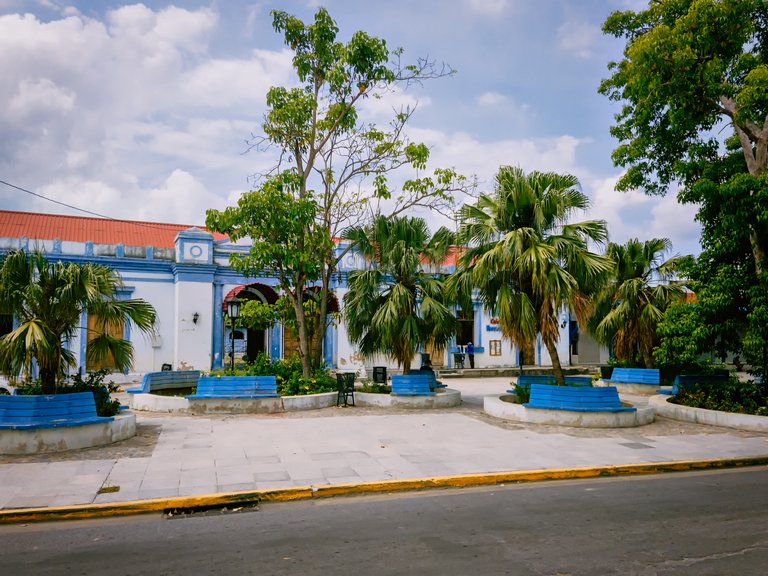
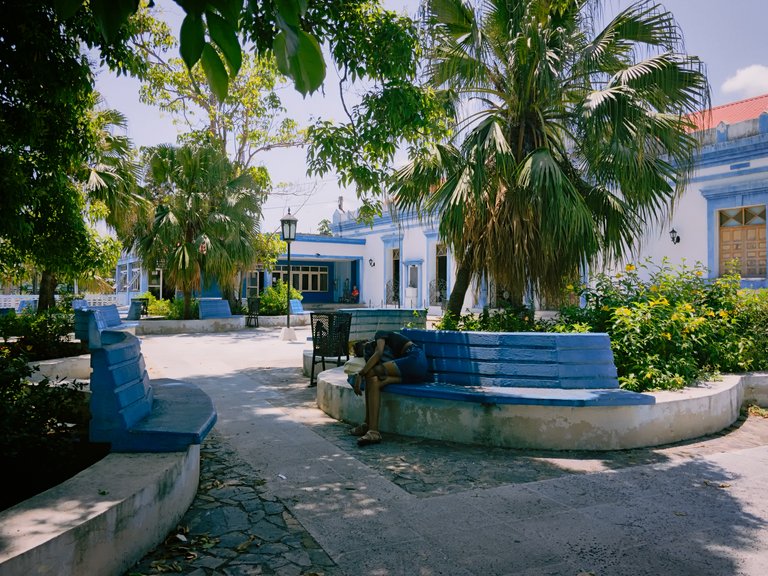
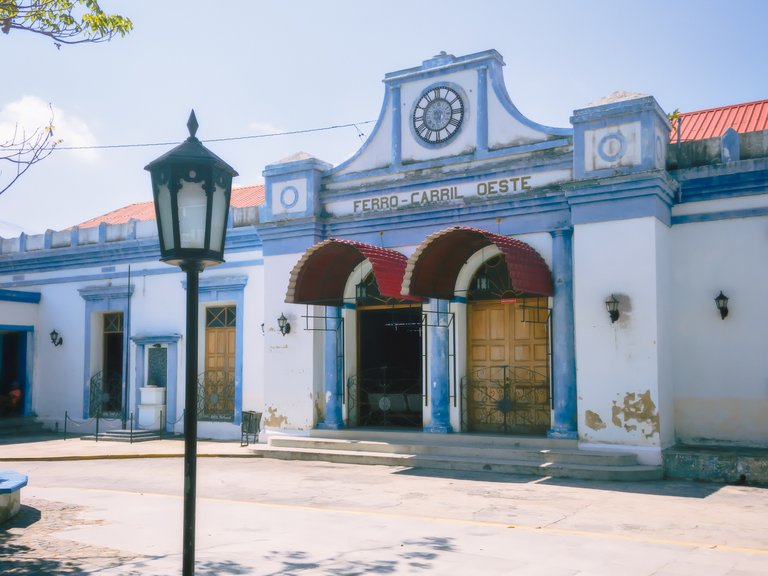
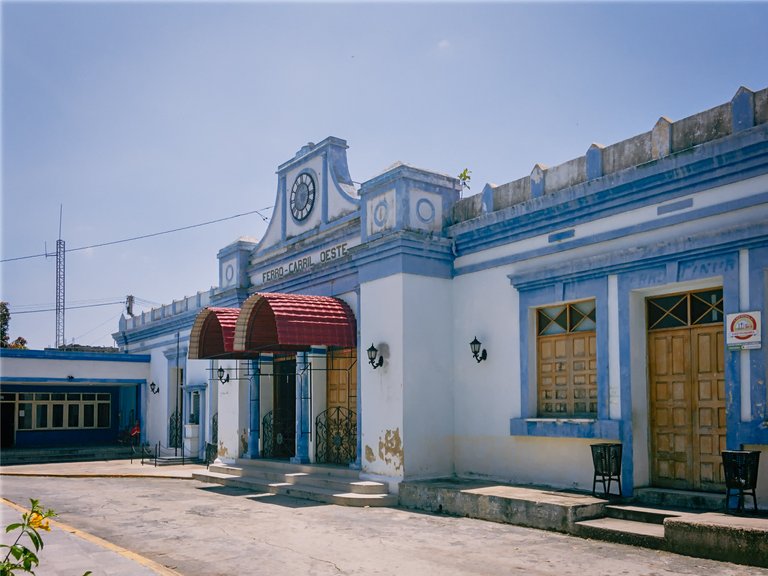
The interior spaces of the train station are spacious and well-ventilated, with enough seating for those waiting to board the train. The station has a cafeteria, a ticket office, a waiting room, and platforms for boarding and disembarking. The architecture of the building is characterized by its colonial style, with high ceilings and large windows that allow natural light and fresh air to circulate inside. Overall, the train station is a beautiful and functional space that reflects the important role that railways played in the development of Cuba's transportation infrastructure.
Los espacios interiores de la estación de tren son amplios y bien ventilados, con suficientes asientos para aquellos que esperan abordar el tren. La estación cuenta con una cafetería, una taquilla, una sala de espera y plataformas para el abordaje y desembarco. La arquitectura del edificio se caracteriza por su estilo colonial, con techos altos y grandes ventanas que permiten la entrada de luz natural y la circulación de aire fresco en su interior. En general, la estación de tren es un espacio hermoso y funcional que refleja el papel importante que desempeñaron los ferrocarriles en el desarrollo de la infraestructura de transporte de Cuba.
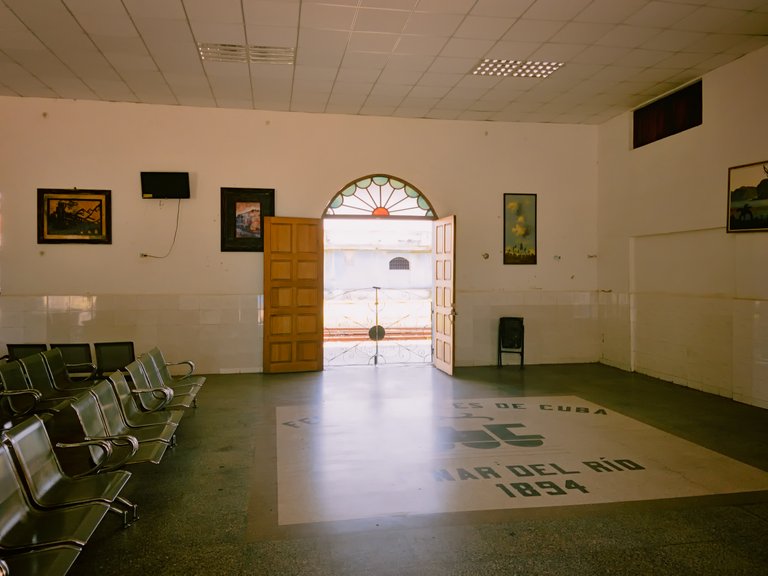
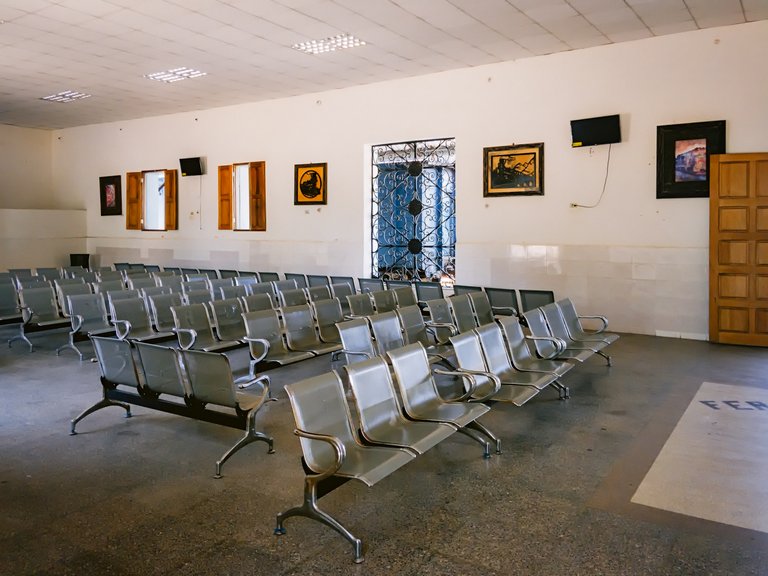
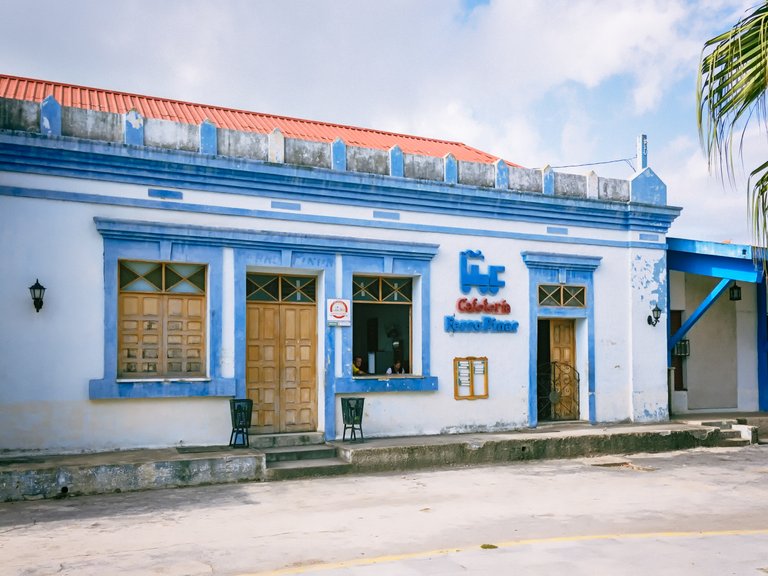
Epilogue / Epílogo
Cabada Avenue, in addition to being an important road in the city, treasures a beautiful history. At its beginning, center, and end, it has emblematic places of the Pinar del Río capital, such as the La Jupiña Factory, the Guasch Palace, and the West Railway Station, all of great local and national relevance. Its design differs from the rest of the streets and avenues of the city, as the laurels that adorn it on both sides provide shade to pedestrians who circulate on its sidewalks, protecting them from the harsh tropical sun. In short, without this avenue, my city would not be the same.
La Avenida Cabada, además de ser un importante vial de la ciudad, atesora una bella historia. En su inicio, cento y final cuenta con lugares emblemáticos de la capital pinareña como son la Fábrica La Jupiña, el Placio de Guasch y la Estación de Ferrocarriles Oeste, todos de gran relevancia local y nacional. Su diseño difiere del resto de las calles y avenidas de la ciudad, pues los laureles que la dornan por ambos lados, regalan su sombra a los transeuntes que circulan por sus aceras, protegéndolos del duro sol tropical. En fin, sin esta avenida mi ciudad no sería la misma.
Did you like the post? I hope so. I would appreciate any comments or suggestions you may have. Thank you very much for your time.
¿Te gustó la publicación? Espero que sí. Agradecería cualquier comentario o sugerencia que tengas. Muchas gracias por tu tiempo.
| Photographer | @ralbe |
|---|---|
 | All photos were taken with my iPhone 11 and edited in Photoshop. Follow me at: htpps://vero.co/ralbe |
Historical data related to dates were obtained from the book "Apuntes para una Historia de Pinar del Río" by Wilfredo Denie Valdés. Convivencia Editions (2011). Other public sources on the internet such as Wikipedia and Ecured were also used.
Los datos históricos relacionados con las fechas fueron obtenidos del libro "Apuntes para una Historia de Pinar del Río" de Wilfredo Denie Valdés. Ediciones Convivencia (2011). También se utilizaron otras fuentes públicas de internet como Wikipedia y Ecured.
Congratulations, your post has been added to Pinmapple! 🎉🥳🍍
Did you know you have your own profile map?
And every post has their own map too!
Want to have your post on the map too?
🙏🙏
Muy bonito post , muchas cosas no se saben de Pinar del Rio , lindas imágenes adornan tu publicación además de la basta información, hace muchos años no voy por Pinar , pero gracias a ti ya me apunte unos cuantos lugares a los que no puedo faltar , uno de los primeros tiene que ser ese Palacio de Guasch. Uff los grafittis los adoro , que bellezas de ese arte callejero , me encanta . En fin gracias por llevarme de la mano y mostrarme tu ciudad 👌👌❤️
Holaa. Lamentablemente el Museo de Ciencias (Palacio de Guasch) está cerrado desde la pandemia y todavía no saben cuando reabrirán, espero que no demoren 3 o 4 años más 😥 Muchas gracias por tu comentario, un saludo.Holaa.
Que bien otro pinareño más en #hive, amigo le comento que no es el primero de Vueltabajo en la plataforma. Somos muchos de veras, no estás solo, puedes unirte a nuestra comunidad @HIVEPINAR, búscanos en Twitter envianos tu contacto a DM para unirte a ella si lo deseas. Para entre todos recibir ayuda, asi como compartir conocimientos o criterios que nos puedan aportar mutuamente. Mi hermano @eduardo900613 te puede ayudar a unirte a la comunidad pinareña. Saludos 👋
Muchas gracias. Traté de unirme a ka comunidad y me da error
Busca el usuario en Twitter y escribe al DM con tus datos para encontrarte, no es una comunidad acá HIVE. Saludos 👋
Hola que bonito Pinar me ha encantado conocerlo a través de tantos pinareños que hablan de su ciudad. Yo nunca la he visitado, me gustaría.
Pinar del Río tiene muy buena comunidad, lo que te pone @jesusdiaz880924 es cierto, se ayudan mucho entre todos. Igual puedes unirte en Telegram a la comunidad de Hivecuba (en caso de que no estés ya je).
Saludos
Gracias por tu comentsrio. Si, ya estoy telegram con HiveCuba. Traté de unirme, pero es a través fe tweeter, qque yo practicamente no uso. Solo comparto ahi desde otras aplicaciones. Un saludo,
Hiya, @ybanezkim26 here, just swinging by to let you know that this post made it into our Honorable Mentions in Daily Travel Digest #1931.
Your post has been manually curated by the @pinmapple team. If you like what we're doing, please drop by to check out all the rest of today's great posts and consider supporting other authors like yourself and us so we can keep the project going!
Become part of our travel community:
Congratulations @ralbe! You have completed the following achievement on the Hive blockchain And have been rewarded with New badge(s)
Your next target is to reach 2250 upvotes.
You can view your badges on your board and compare yourself to others in the Ranking
If you no longer want to receive notifications, reply to this comment with the word
STOPCheck out our last posts:
@tipu curate
Upvoted 👌 (Mana: 43/63) Liquid rewards.
🙏🙏🙏
Thanks!! 🙏🙏🙏
Que lindas fotos que resaltan la belleza de nuestra ciudad 👌
Muchas gracias por el elogio a las fotos y sobre todo, a mi ciudad 🙏🙏
Todos los habitantes de Vueltabajo deberían conocer la historia de su localidad, muchas felicidades por las imágenes de tu publicación captan muy bien la belleza urbana de nuestras avenidas cabeceras. En los mensajes del post pude leer como te recomendaban unirte a la comunidad pinareña, me uno a la recomendación. Puedes encontrarme en mis redes sociales, para compartir contactos, fortalecer nuestro grupo contigo para trabajar entre todos en fortalecer la colmena. Saludos cuenta con nuestro apoyo 🤝
Muchas gracias por tus palabras. Veré que puedo hacer pues nno soy muy fan de Twitter y decla mayoría de las redes sociales. Dectodos modos lo intentaré. Gracias
Excelente post. La historia pinareña, su toponimia es fascinante. Fotos patrimoniales. Un abrazo fuerte.
Muy agradecido por tu amable comentario. Un abrazo.
Soy pinareño y la historia mía me gusta mucho.
Pues me alegra mucho saberlo. Gracias por tu apoyo!!!
Lovely pictures, dedicated walk ways should be a must on any city road.
And plantation on both sides of road make it alive
Thanks for sharing
Thanks for your kind words. 🙏🙏
Felicidades, un post muy instructivo. Valioso encuentro con la historia local y la toponimia pinareña.
Muchas gracias @raima, me alegra que texhaya gustado. Un saludo.
Muchas gracias pir comentar, espero que puedas visitar Viñales, es un lugar muy especial